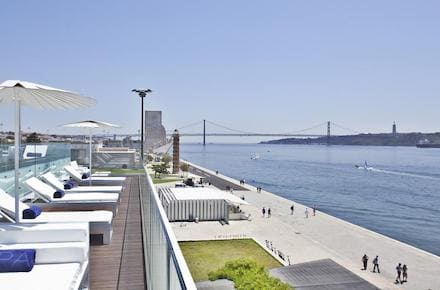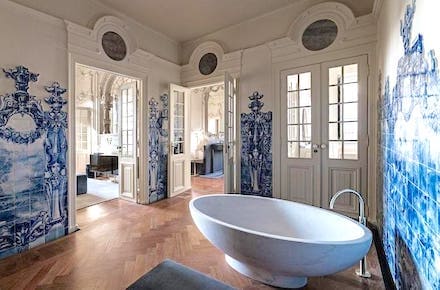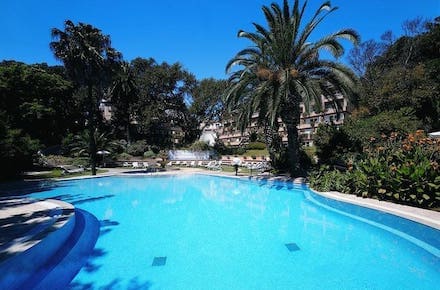Alfama
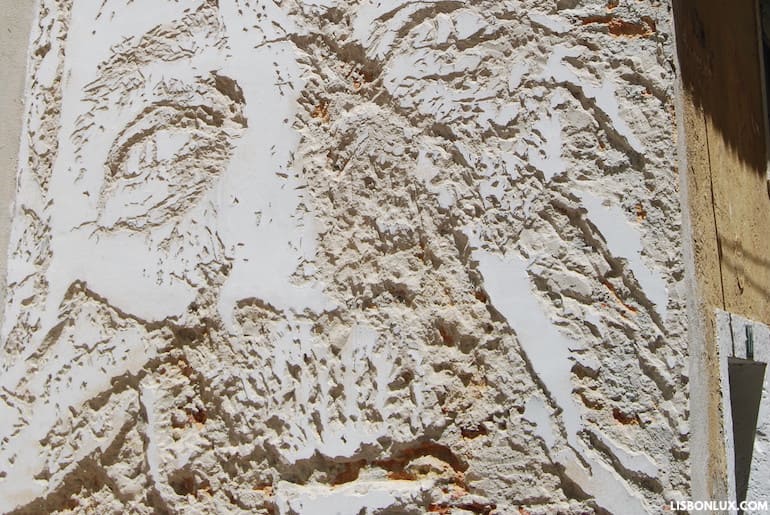
Vhils, whose real name is Alexandre Farto, is currently one of the biggest names of the street art world, and one of the first faces that he carved in Lisbon is hidden behind the cathedral, on Travessa das Merceeiras, just a few feet from the Memmo Alfama Hotel.
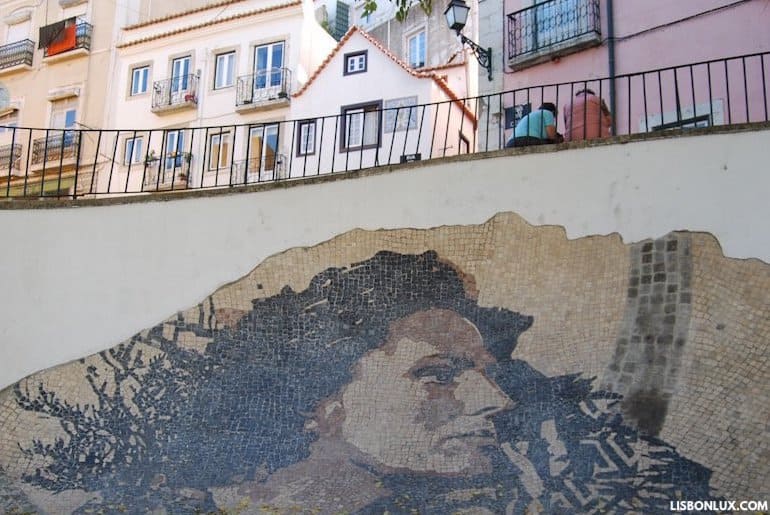
Here Vhils paid tribute to Fado diva Amália Rodrigues, this time using the traditional cobblestone pavement. It dates from 2015, and is found on Calçada do Menino Deus.
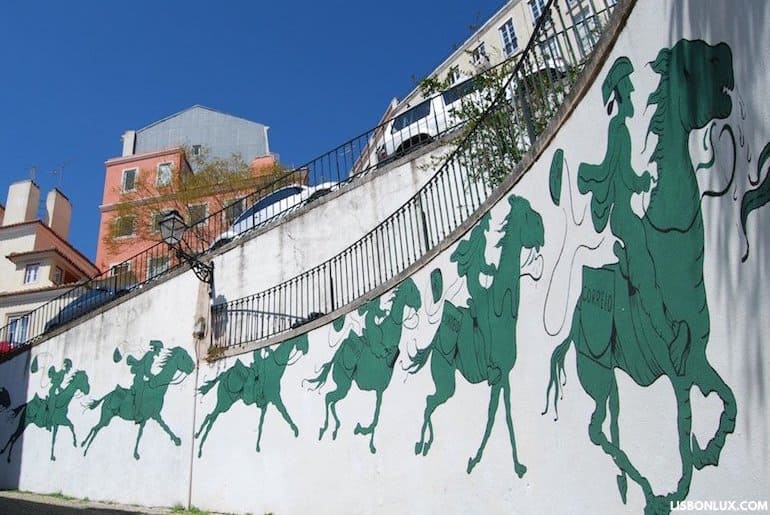
Illustrator Nuno Saraiva created this mural on Travessa da Mata, not far from the cathedral. It’s called “Cavaleiros da Posta Real” and the inspiration came from the horses of Etienne-Jules Marey, the 19th-century photographer that was one of the pioneers of animated film. The goal is to recall the commotion that once surrounded the neighboring Correio Velho Palace.
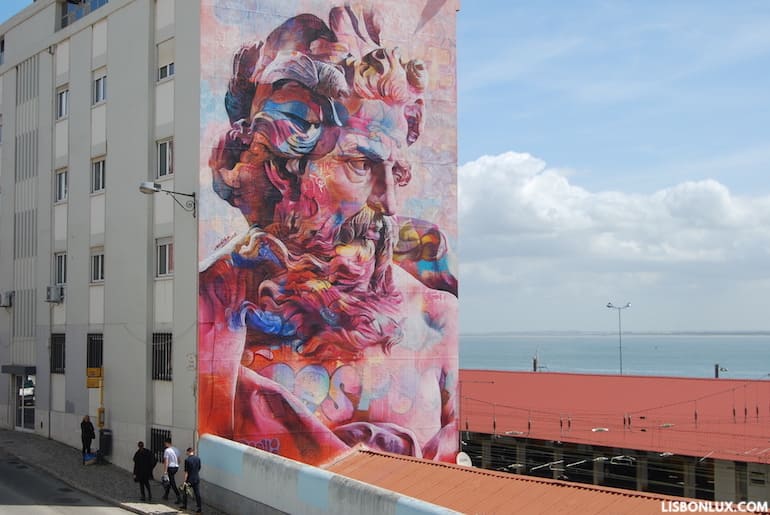
Poseidon, the god of the sea, was painted by the artists known as PichiAvo on the side of a building found a short walk from Santa Apolónia station (on number 65 of Calçada de Santa Apolónia).
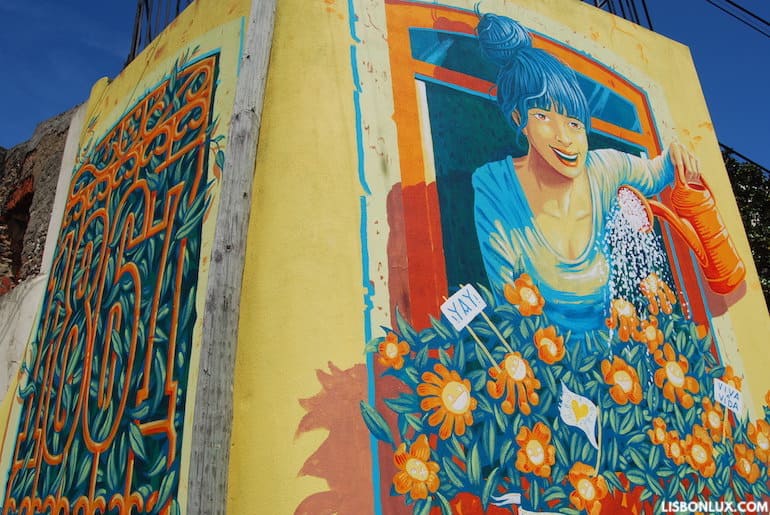
This mural by Mário Belém celebrates life. It was created in 2017, to celebrate the 150 years since the death penalty was abolished in Portugal. It can be seen on Calçada de Santa Apolónia, not far from the train station.
Bairro Alto
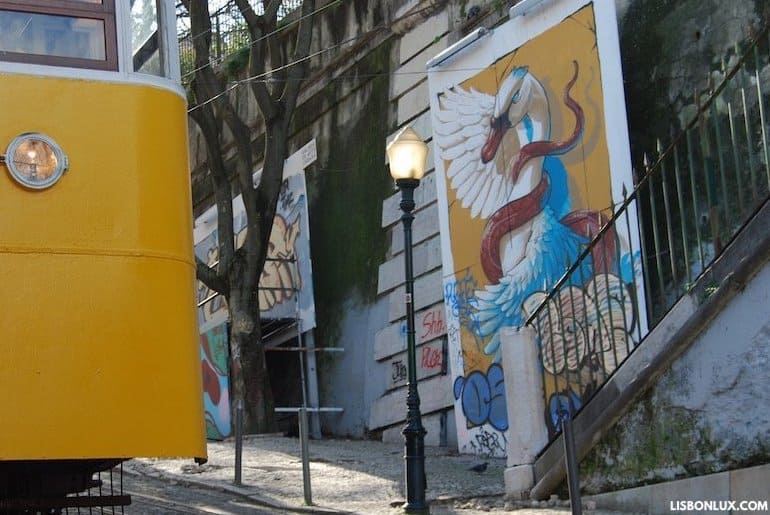
Calçada da Glória and Largo da Oliveirinha, which are crossed by the Glória funicular, make up the official street art gallery, with seven panels offered by the City Council. It was inaugurated in 2008, and still organizes temporary thematic exhibitions.
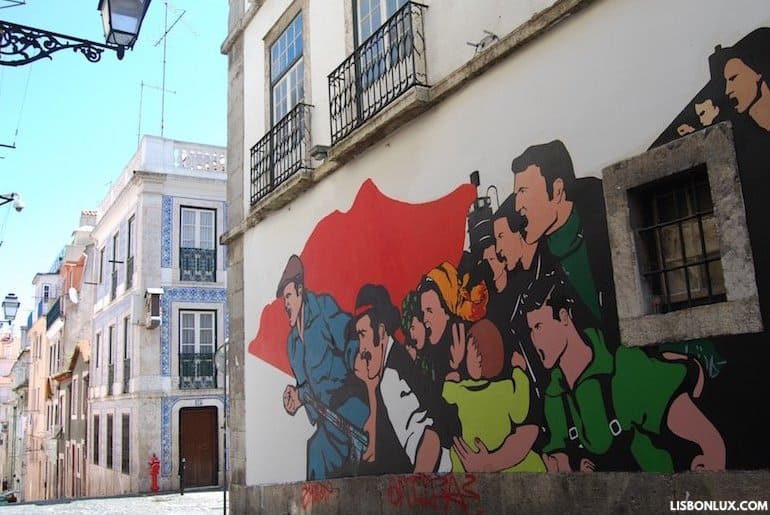
Leftist propaganda covered Lisbon’s streets in the 1970s, and this one in Bairro Alto recalls those days. It’s found on Travessa dos Fiéis de Deus, and was created in 2009 by the artists António Alves and RIGO, obviously influenced by Maoist design.
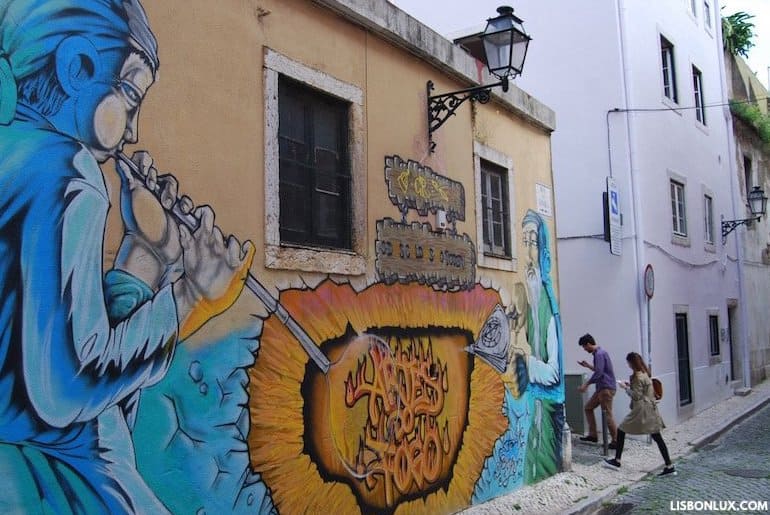
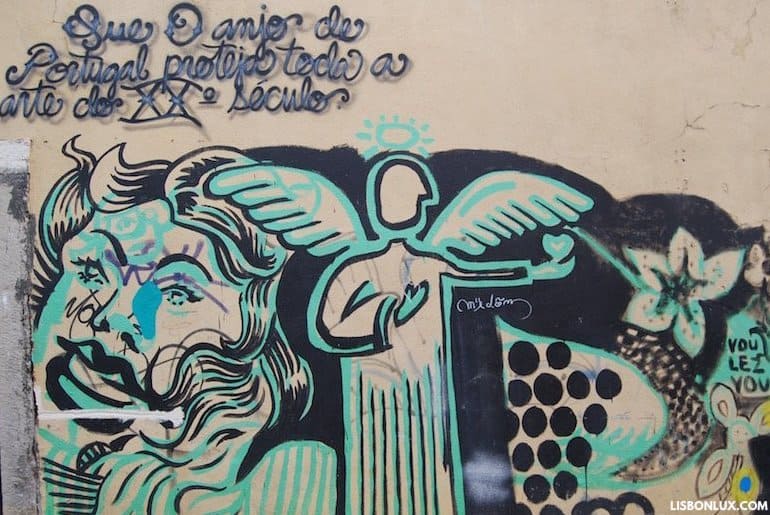
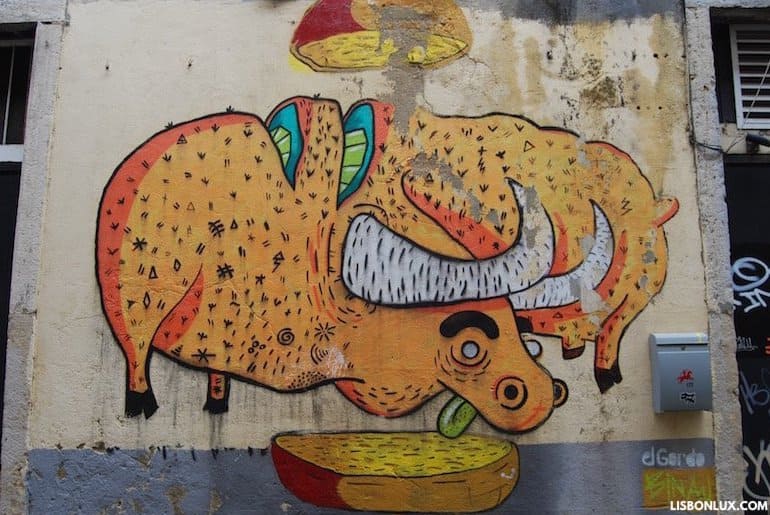
Unlike most other works on the streets of Bairro Alto, these murals have been able to survive for several years. They are found on Rua da Vinha since 2012, while on the parallel Rua de São Boaventura is a more recent work by Binau.
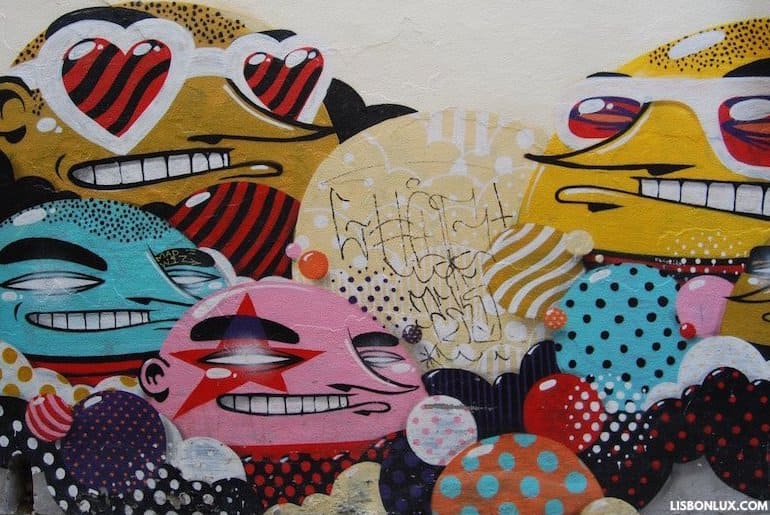
On Travessa dos Fiéis de Deus is this piece by the well-known artist from Luxembourg, Sumo Doubledevil.
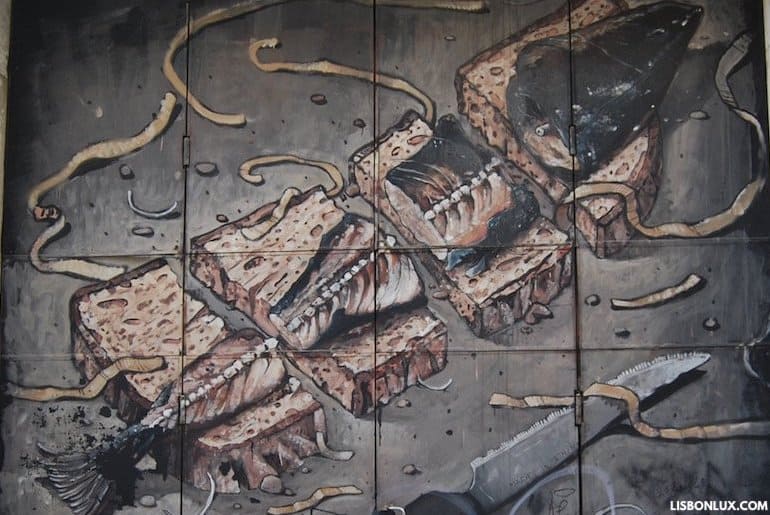
This curious sardine on bread can be seen on Rua Luz Soriano and was created by local artist Regg Salgado.
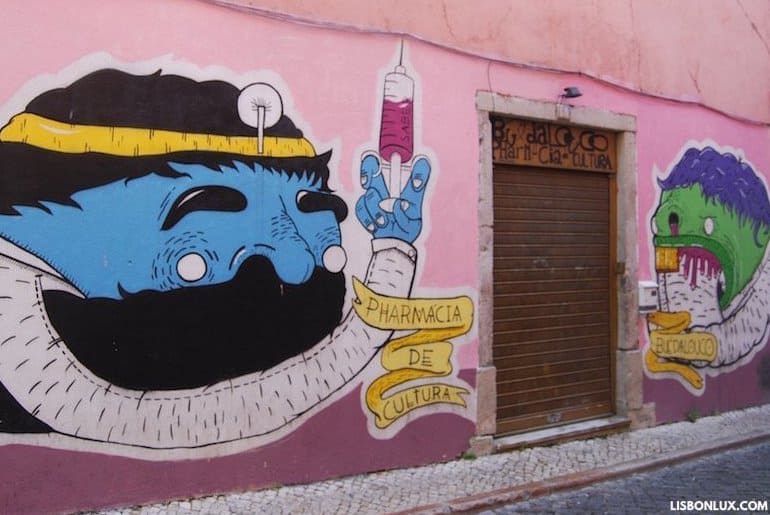
This "Culture Pharmacy" is found on Rua do Norte.
Chiado
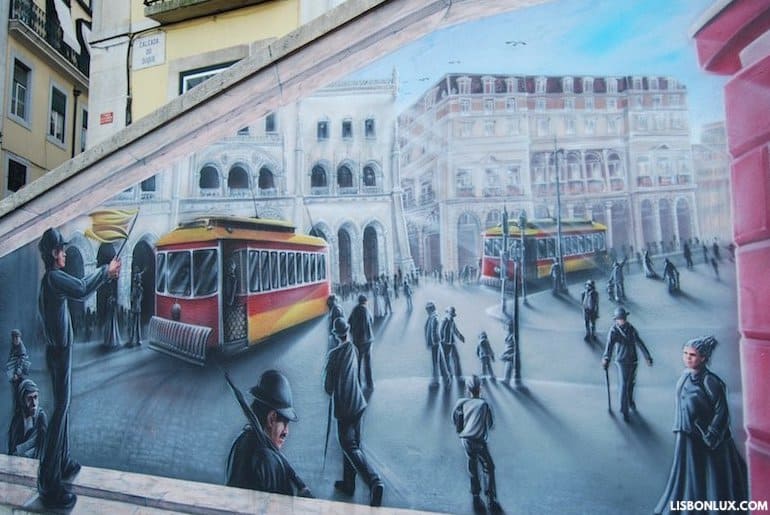
This piece by Brazilian-born artist Oliveiros Rodrigues da Silva Junior, also known as “Utopia63,” is found on Calçada do Carmo. It illustrates Lisbon from decades ago, in a scene by Rossio Station.
Graça
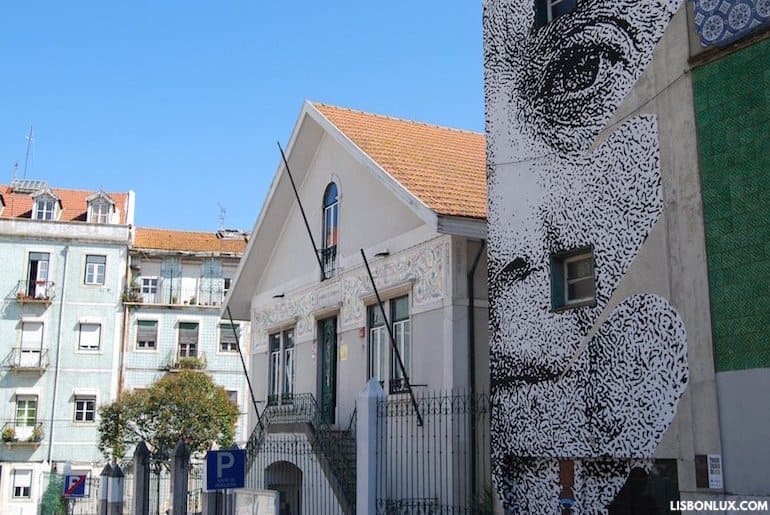
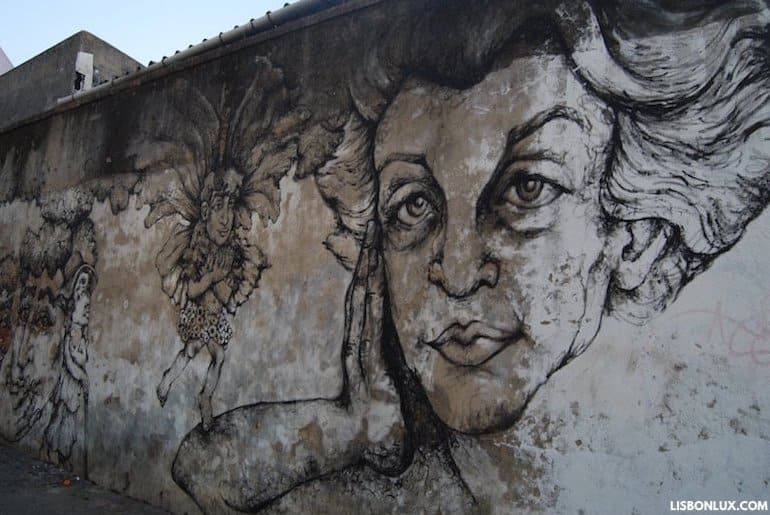
In 2014, a group of artists decided to pay tribute to historic personalities of Portuguese literature with links to the Graça neighborhood. Therefore, poet Sophia de Mello Breyner’s face, created by the artist Eime, is found on Rua Josefa de Óbidos, while Natália Correia and Florbela Espanca are illustrated on Travessa do Monte, in a work by Mariana Dias Coutinho. Nearby are the viewpoints of Graça and Senhora do Monte .
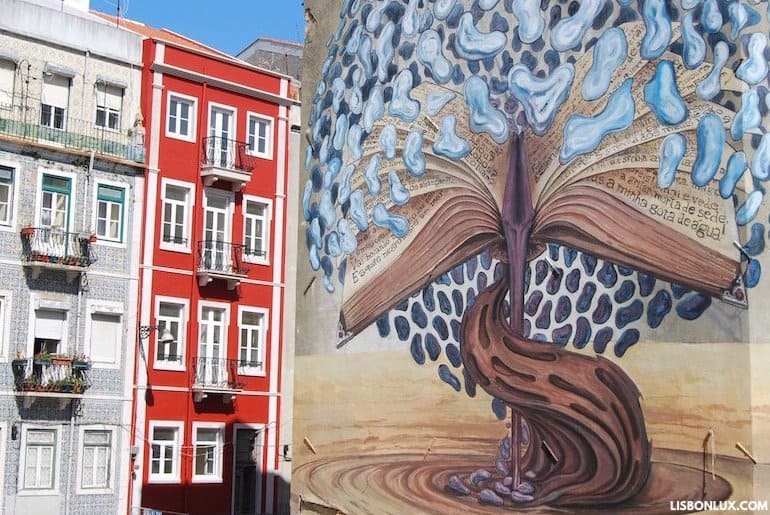
João Maurício, aka Violant, created this work on Rua Natália Correia, much photographed by those passing by on tram 28 .
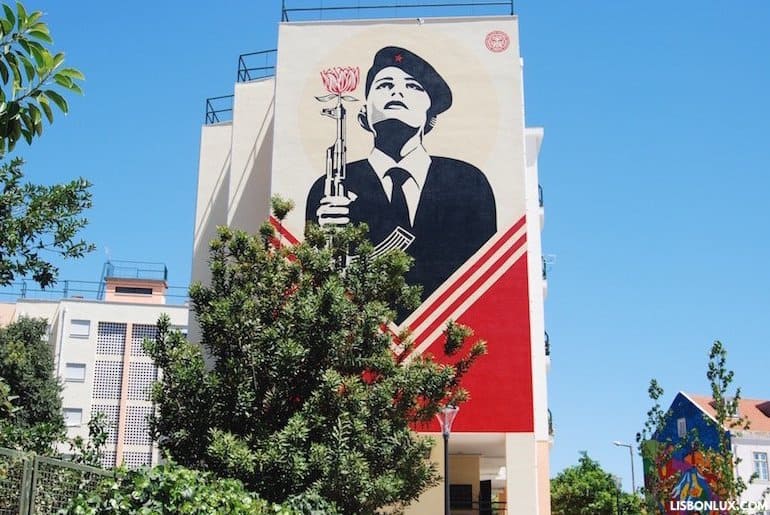
Also on Rua Natália Correia, this piece by Shepard Fairey (the American artist known for the famous Barack Obama "Hope" poster) illustrates a woman holding a gun with a flower in the barrel.
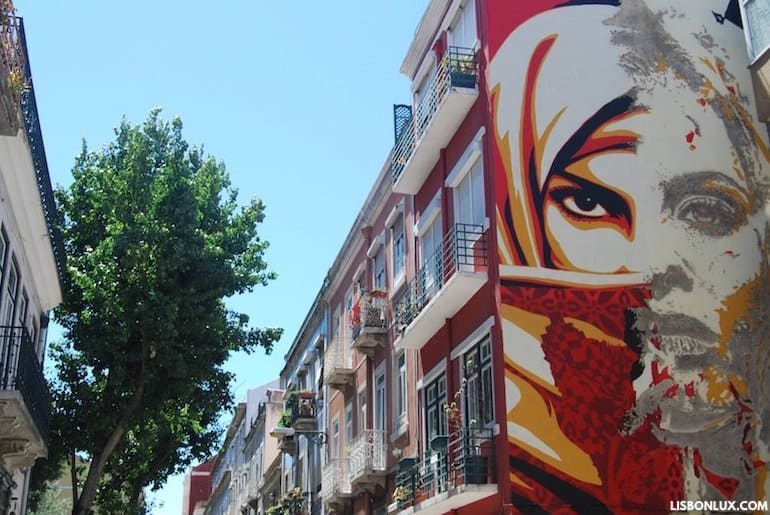
Shepard Fairey created a second piece in the neighborhood, this time on Rua Senhora da Glória. He painted half of a female face, while the Portuguese artist Vhils carved the other half.
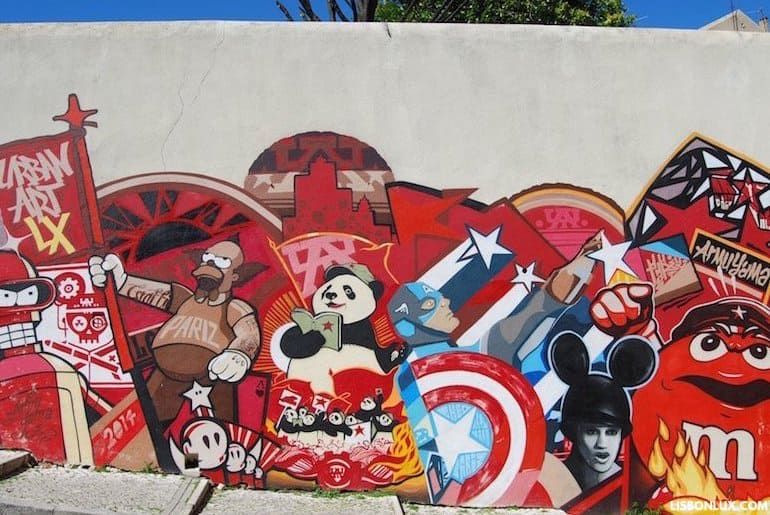
Halfway between the São Vicente Monastery and the Graça viewpoint, on Travessa de São Vicente, is this mural created by Pariz One and Mr. Dheo. It remembers the April 25th Revolution, but here the revolutionaries are popular animated characters, in order to draw the attention of the younger population.
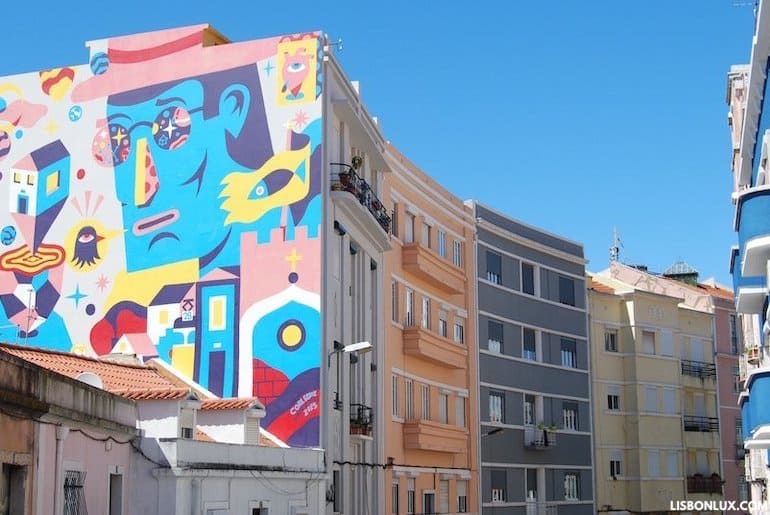
This colorful piece, created by akaCorleone, is hidden at the end of Rua Damasceno Monteiro, but not far from the Senhora do Monte viewpoint.
Belém
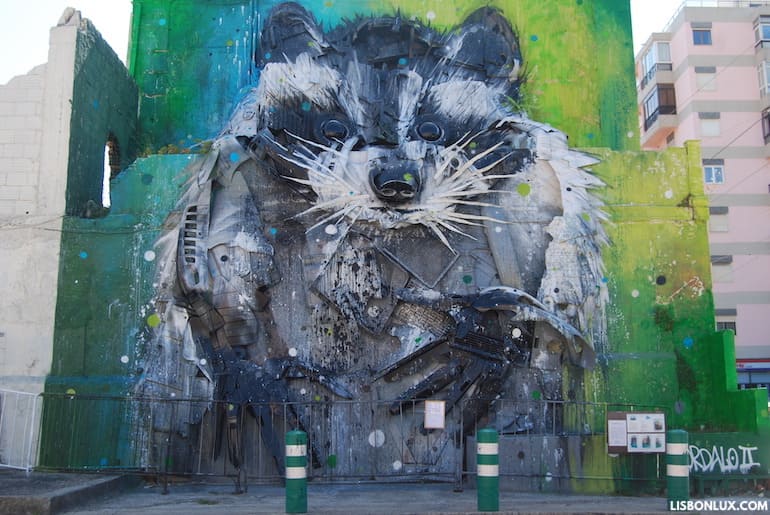
Combining painting and sculpture, Bordalo II uses old tires, bumpers, computer parts, and other discarded stuff from wastelands to create three-dimensional animals, demonstrating that one man’s trash is another man’s art. This racoon is found behind the Belém Cultural Center.

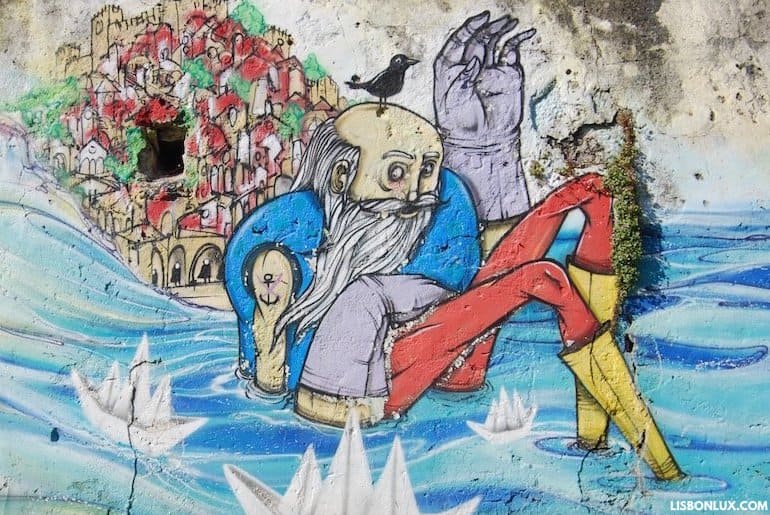
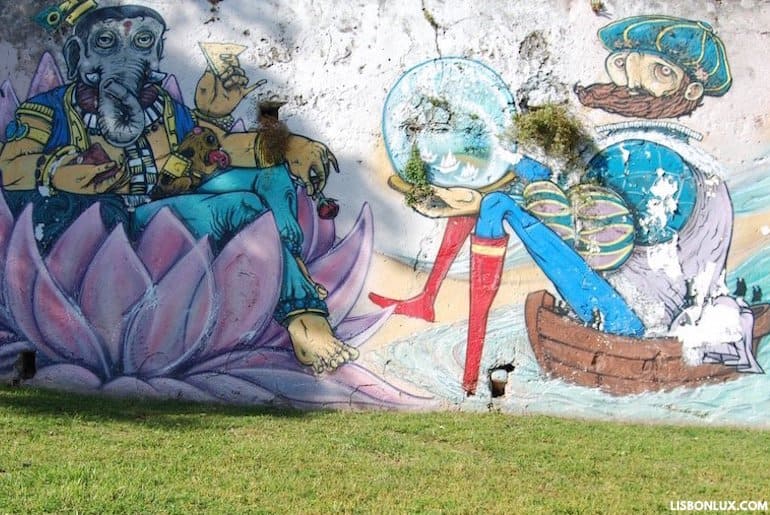
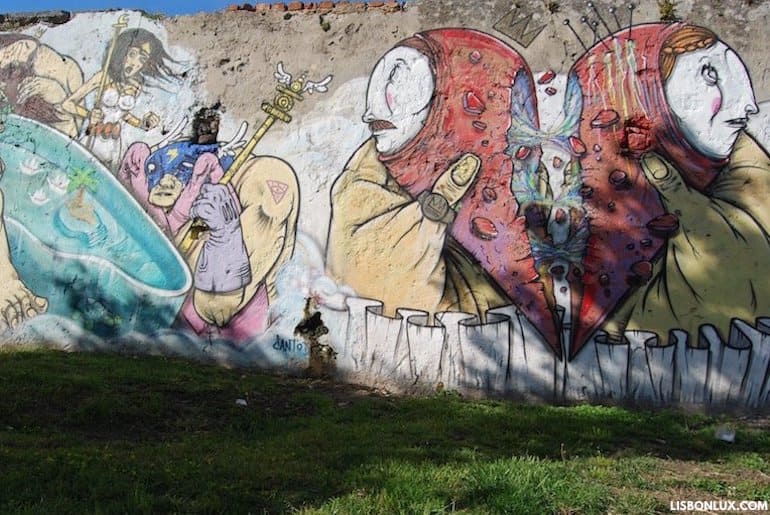
This mural faces the river by the Carriages Museum , on the departure point of the ships of the Age of Discovery. It depicts the ten cantos of Camões’ epic poem "The Lusiads." Sponsored by the weekly newsmagazine Visão on its 20th anniversary, it was created by the duo ARM Collective, MAR and RAM.
Algés
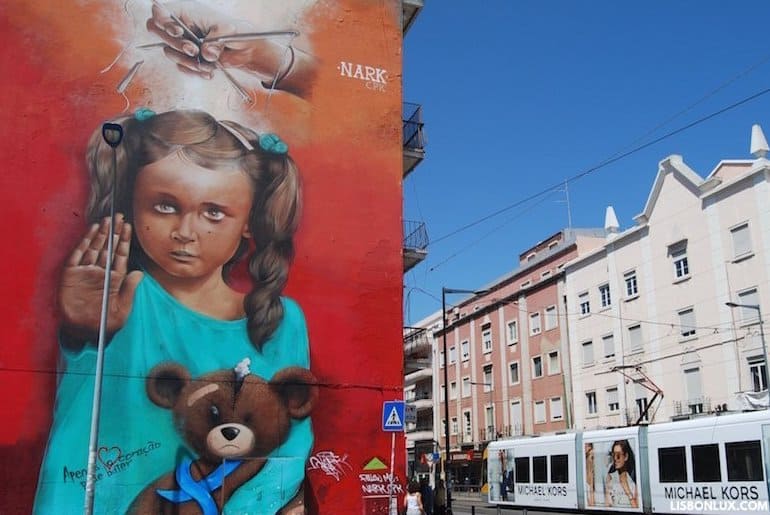
This image of a girl with her arm stretched out -- indicating "stop!" -- and with an adult hand manipulating her movement like a puppeteer, is meant to raise awareness of child abuse and was created by the artist Nark. It was unveiled in April of 2017 and can be seen in Praça D. Manuel I, by the next-to-last stop of tram 15 .
Avenidas Novas
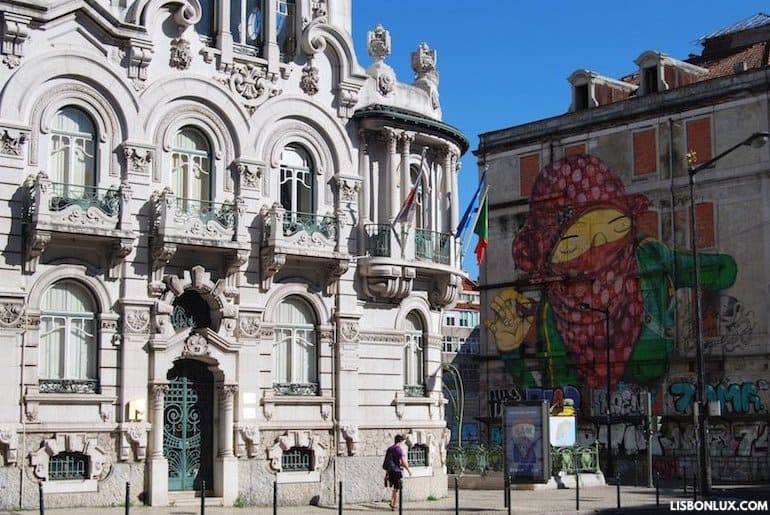
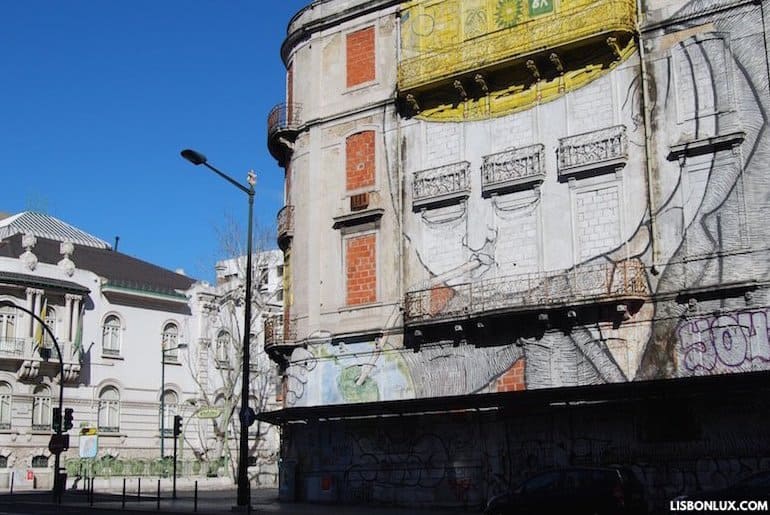
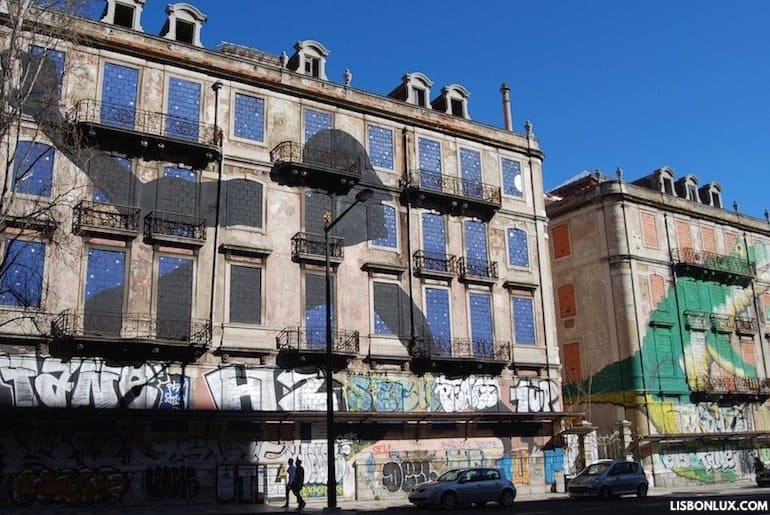
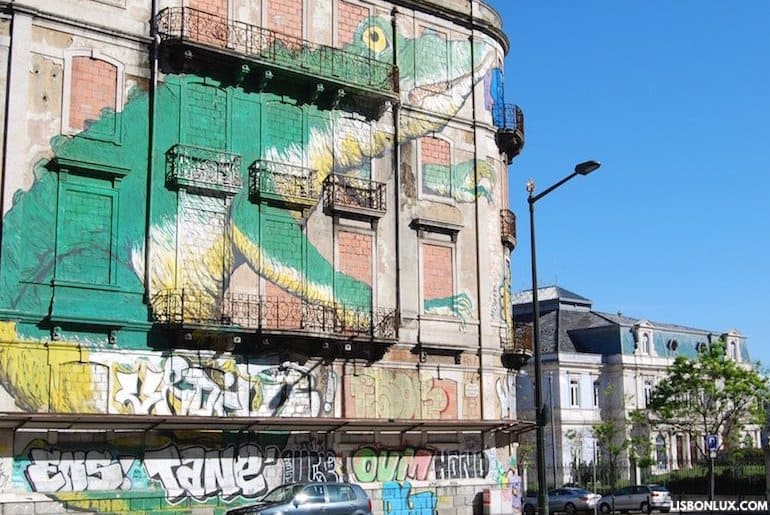
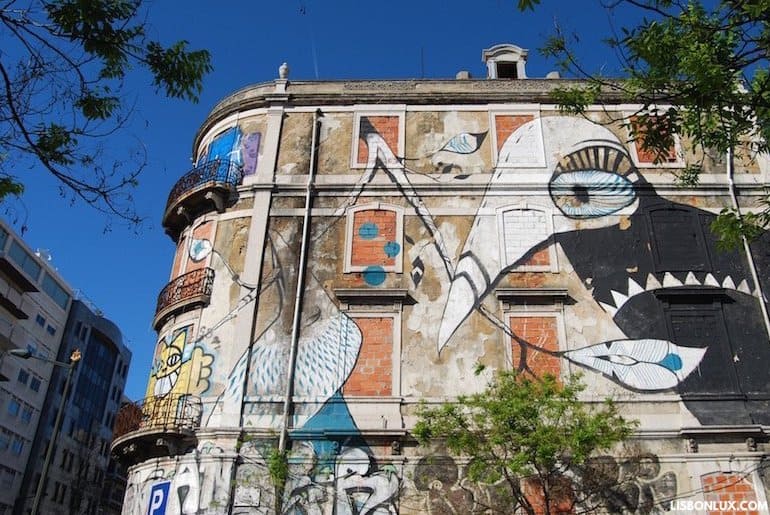
Several international artists -- the Brazilians Os Gémeos, the Italians Blu and Eric Il Cane, and the Spaniard SAM3 -- are responsible for this work on three empty buildings in one of the city’s busiest avenues, Avenida Fontes Pereira de Melo. It was considered one of the world’s top 10 works of street art by the British newspaper The Guardian.
Amoreiras

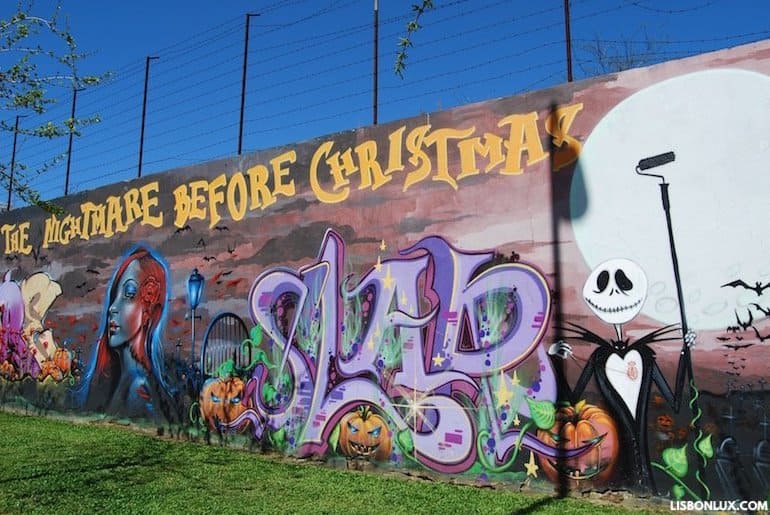
This mural in Amoreiras (Rua Conselheiro Fernando Sousa) is one of the oldest in Lisbon. Some works are older than others, and it has often attracted the city’s few female artists.
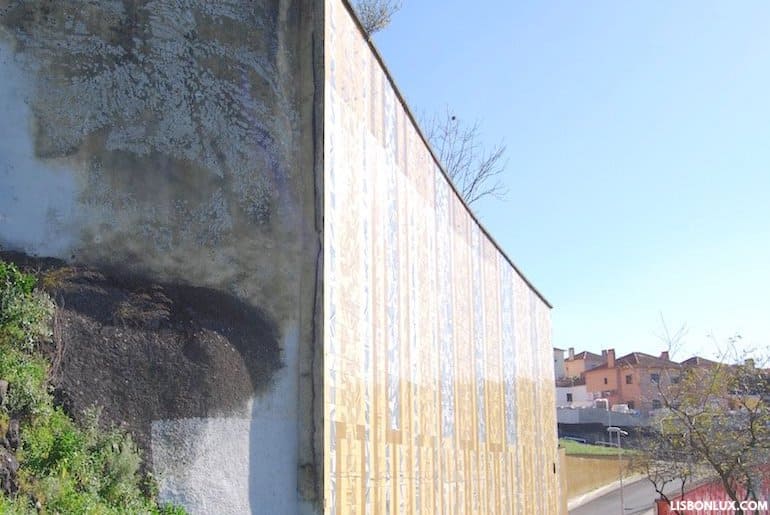
Next to a tile panel by artist João Abel Manta by the road of Avenida Calouste Gulbenkian, not far from the aqueduct , is another of Vhils’ many faces. Carved in 2012 with drills and hammers, it has become a victim of pollution and of the sun.
Alcântara
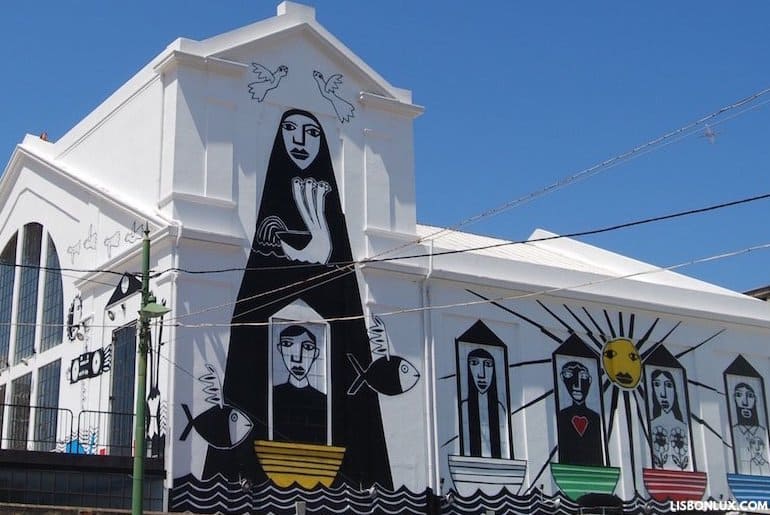
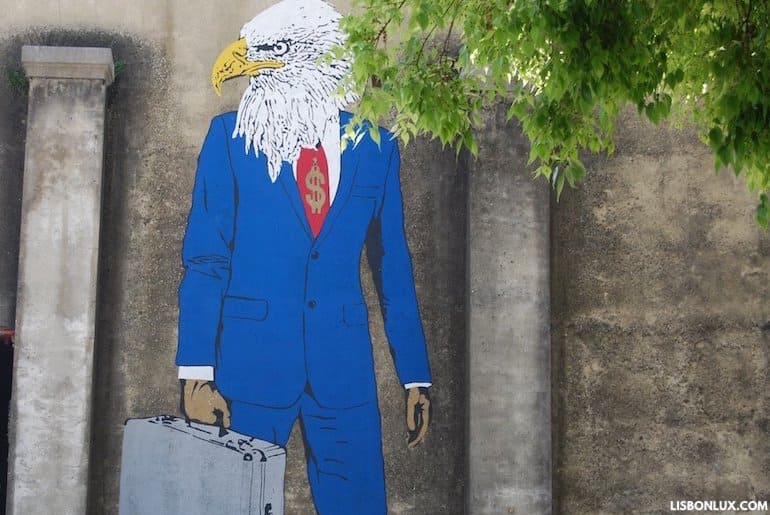
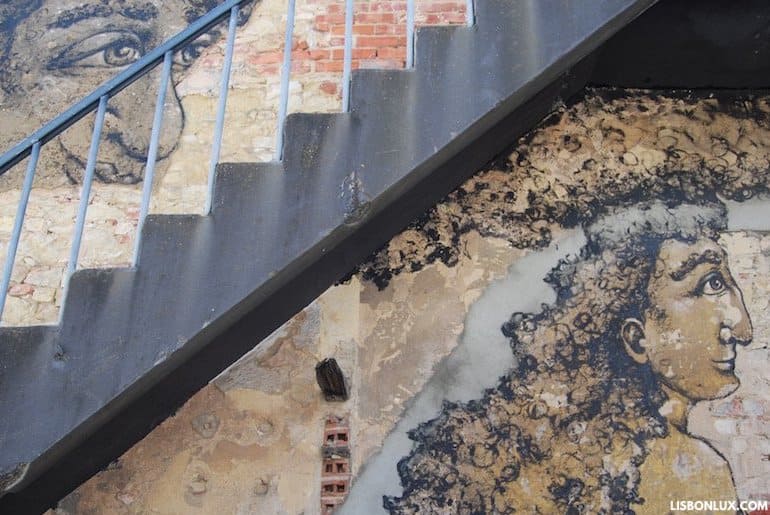

At the "creative factory" that is the Lx Factory complex, there are always over a dozen works by some of the biggest artists, including Bordalo II with his gigantic bee made of trash.
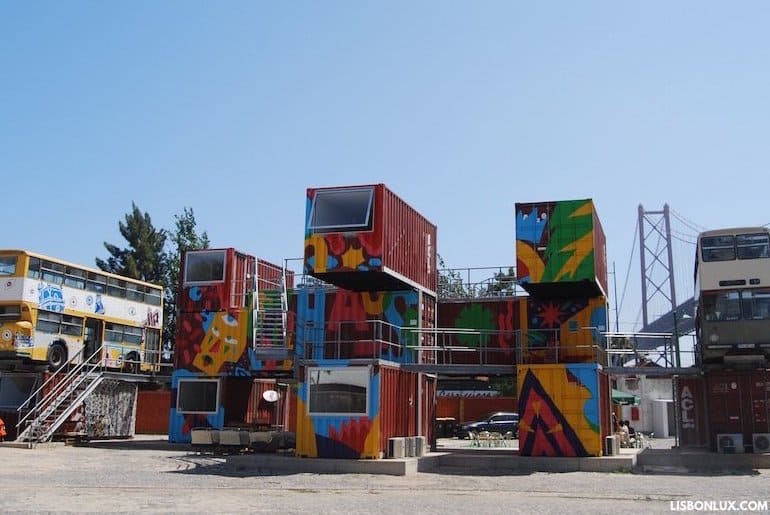
Next to Lx Factory is the coworking space Village Underground, made up of several old containers and buses. It’s all now one big piece of street art, created by akaCorleone.
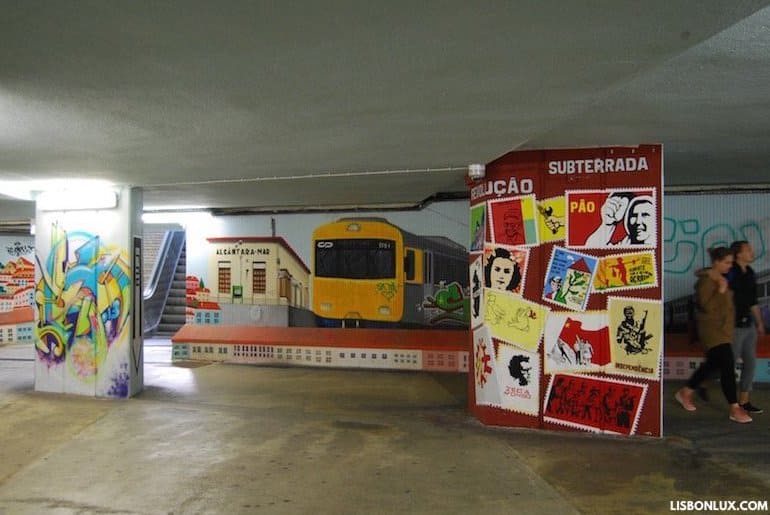
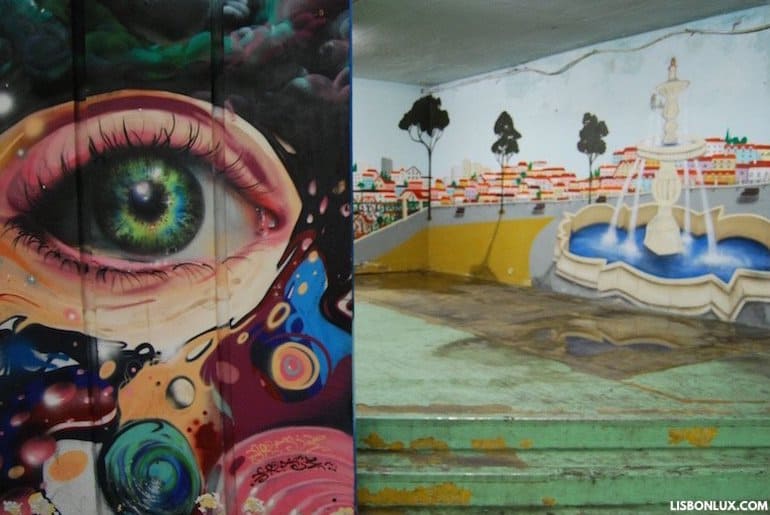
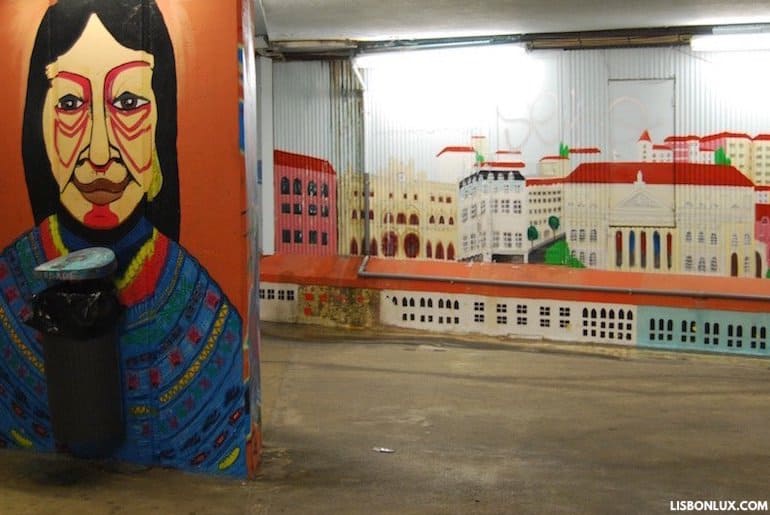
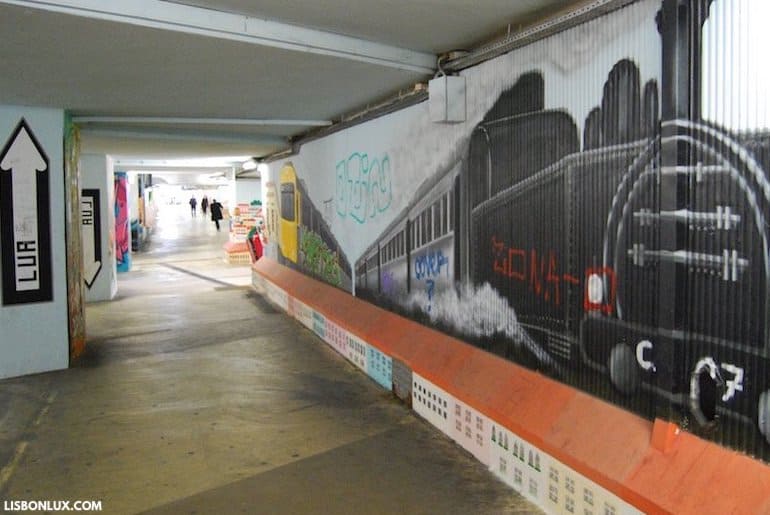
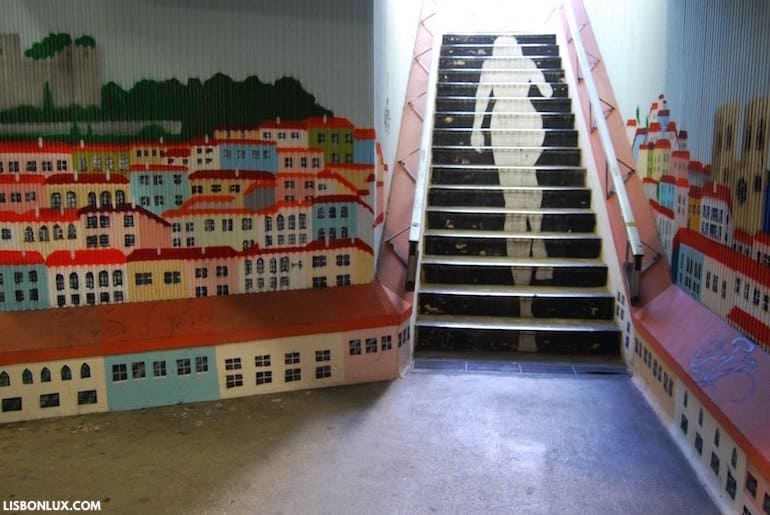
Several artists worked on the art that can now be seen on the underpass that takes you to the Alcântara-Mar train station and to the Santo Amaro docks . Some illustrate monuments, other represent city views.
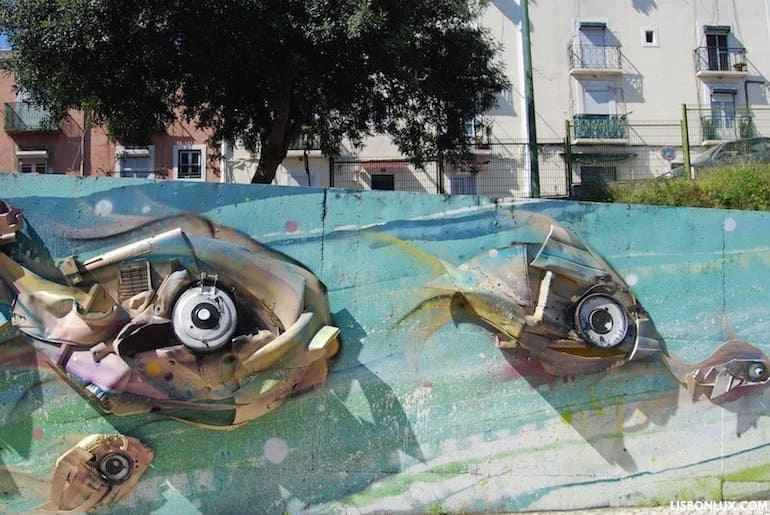
On Avenida de Ceuta, across from the Alcântara-Terra train station is this piece by Bordalo II, this time using trash to create a fish scene.
Intendente
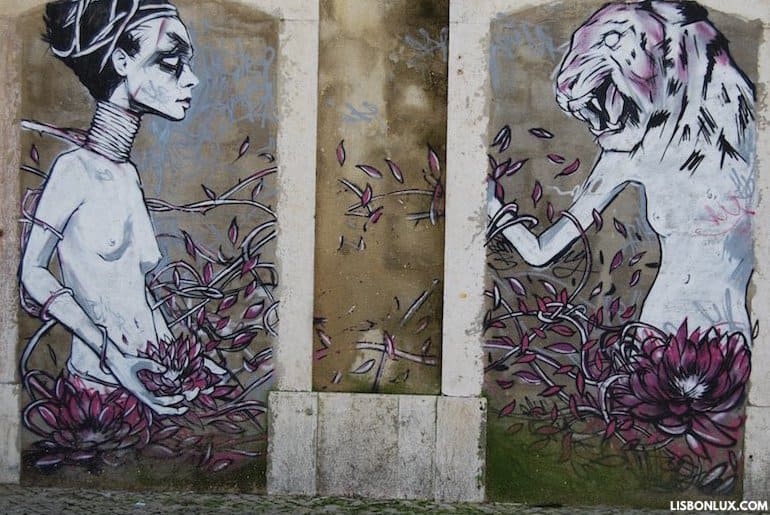
One of the buildings on Largo do Intendente that hasn’t yet been renovated, now features a piece by Tamara Alves, one of the best-known female Portuguese artists in the street art world.
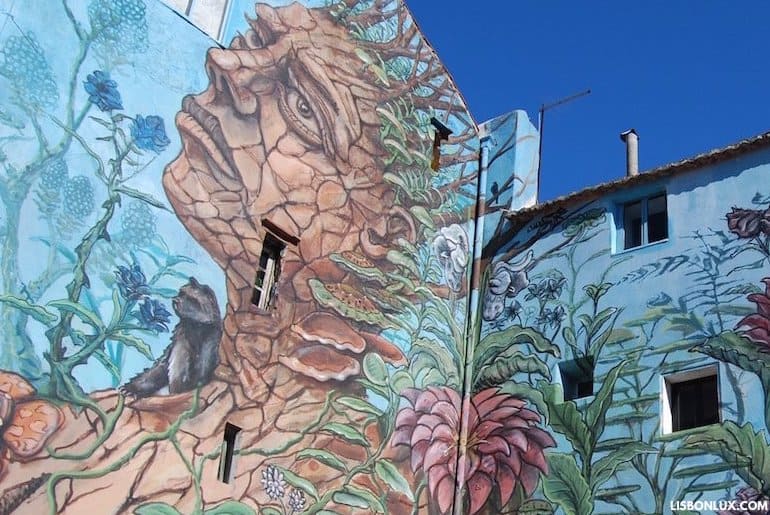
This impressive piece covers an entire building on Rua do Saco, not far from Intendente. It was created by Violant.
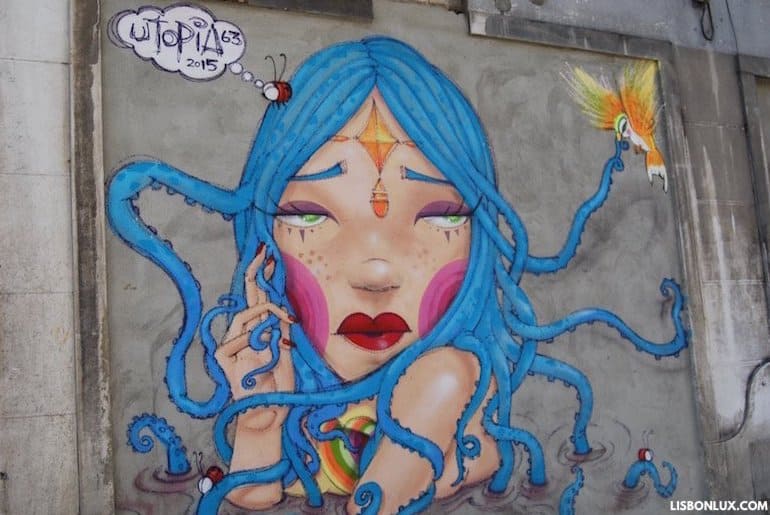
Another piece by Brazilian artist Utopia63, this time on Rua Antero de Quintal.
Mouraria
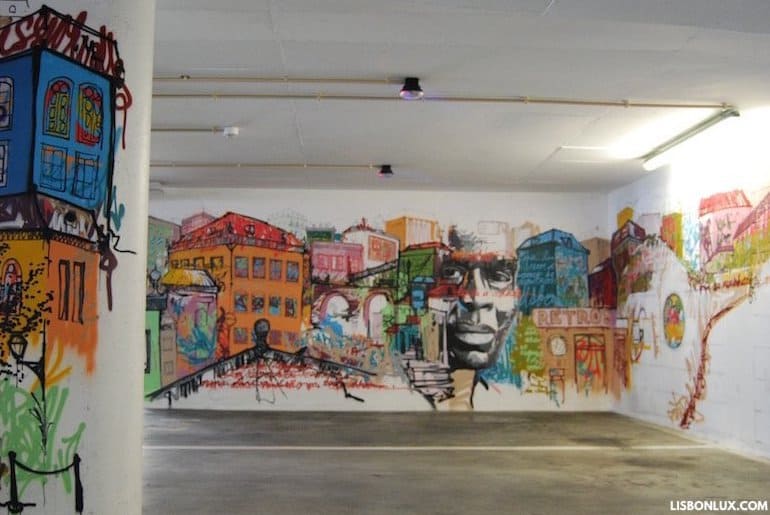
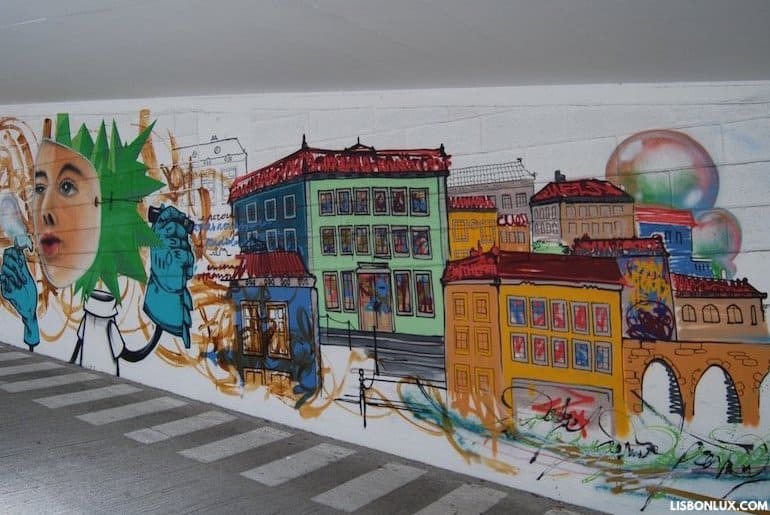
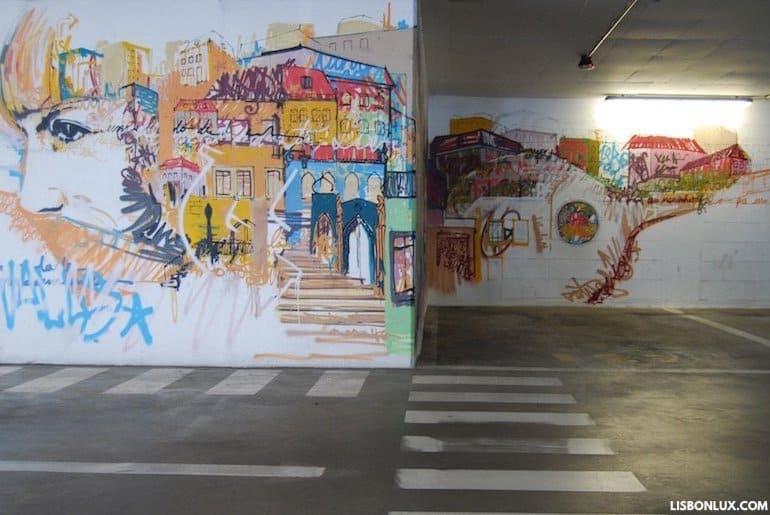
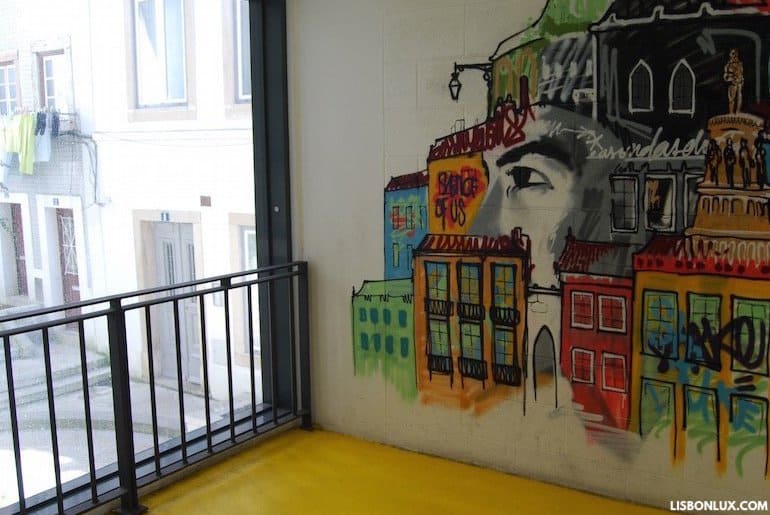
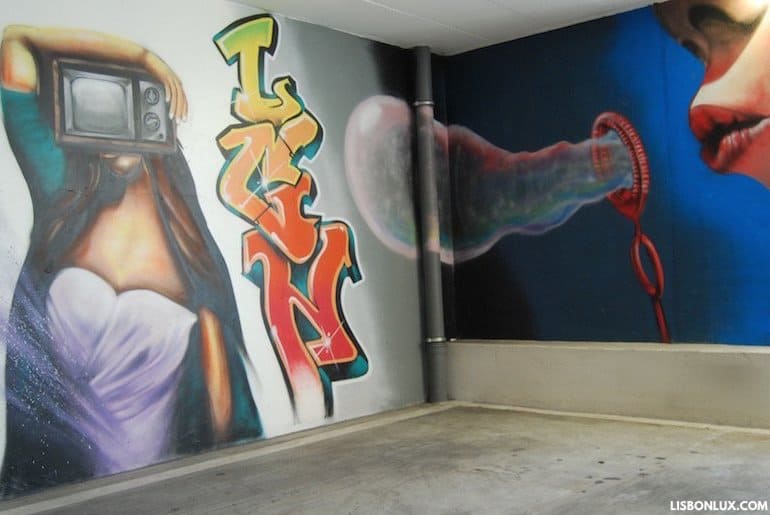
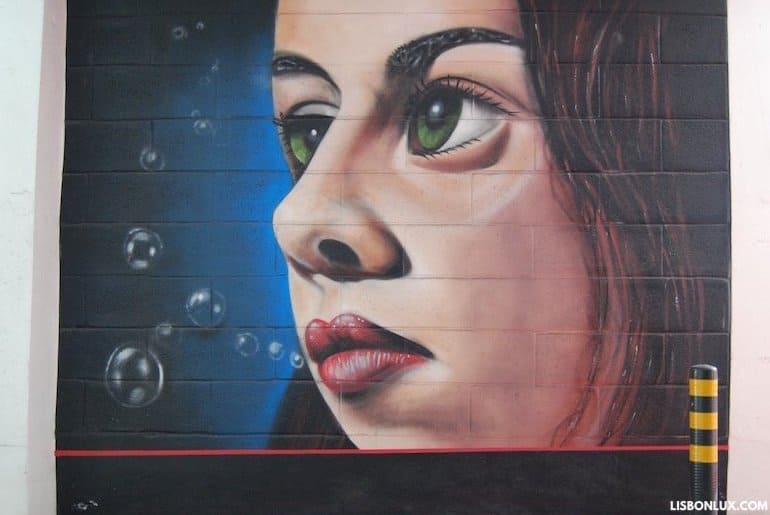
The former market Chão do Loureiro, found between downtown and the castle, is now a car park with several levels, each one with works by five of the most acclaimed national street artists (Mar, Miguel Januário, Nomen, Paulo Arraiano and Ram). You’re free to enter, no need to park your car.
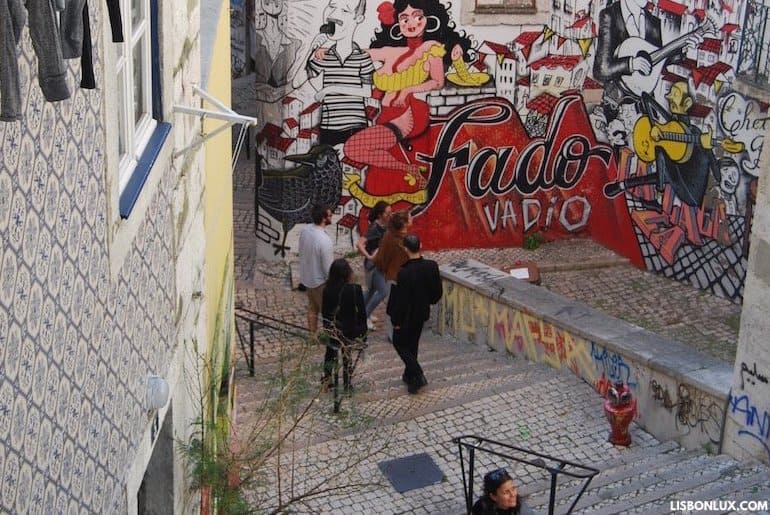
Climbing Escadinhas de São Cristóvão, between Rua da Madalena and the Church of St. Christopher in Mouraria , you find this large mural by different artists, who illustrated the amateur fado music tradition.
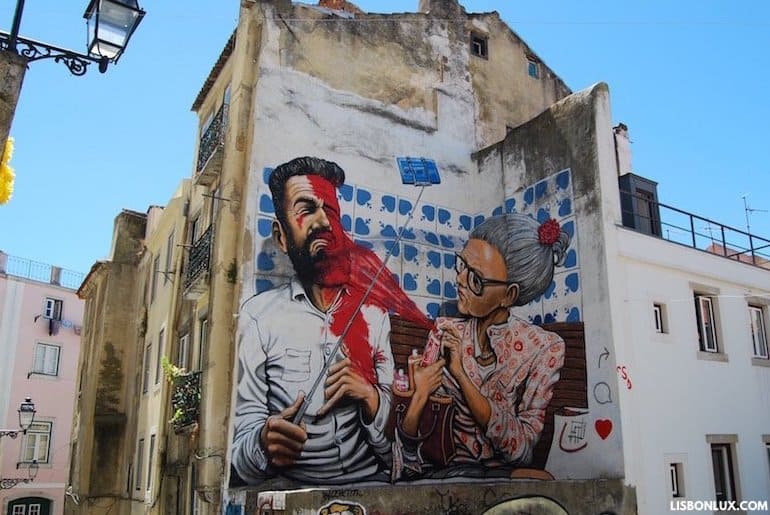
This piece was created in July of 2016 by the Italian artist Andrea Tarli. You can find it on Largo da Achada.
Avenida da Liberdade
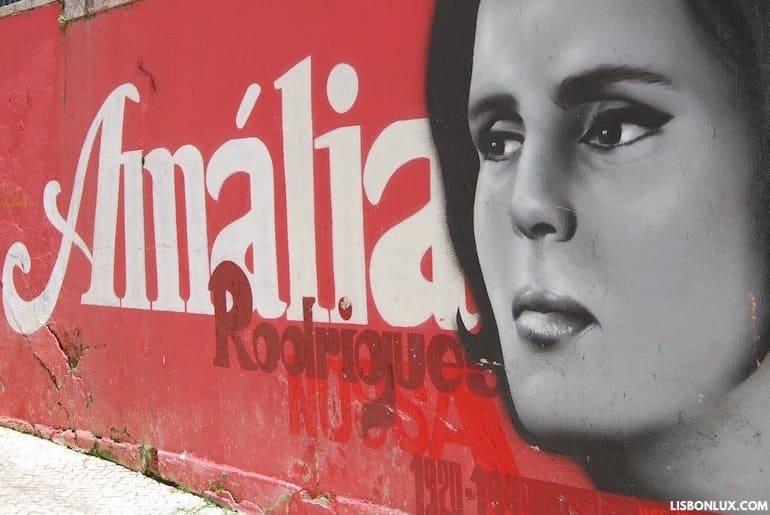
This mural painted by Mr. Dheo and Mosaik is found on Travessa de Santo Antão, by Avenida da Liberdade . It’s a tribute to fado singer Amália Rodrigues, created ten years after her death.
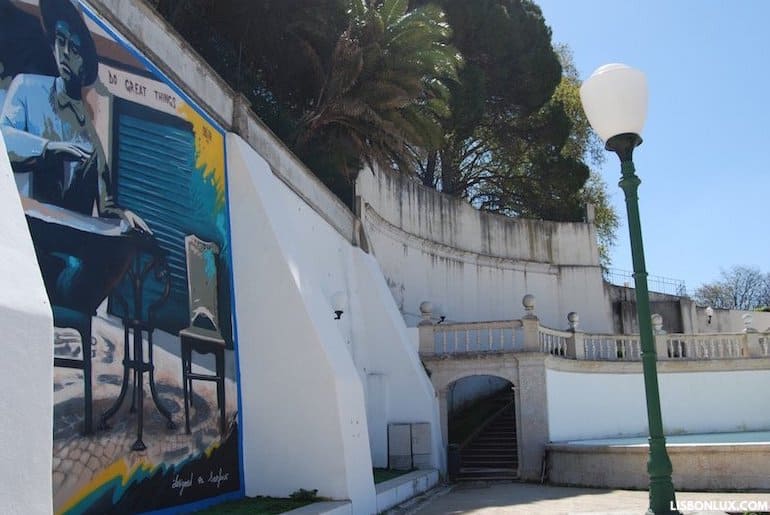
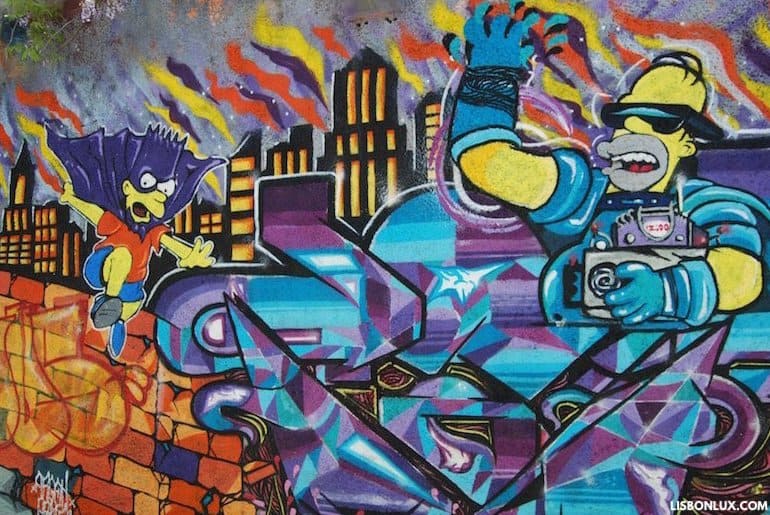
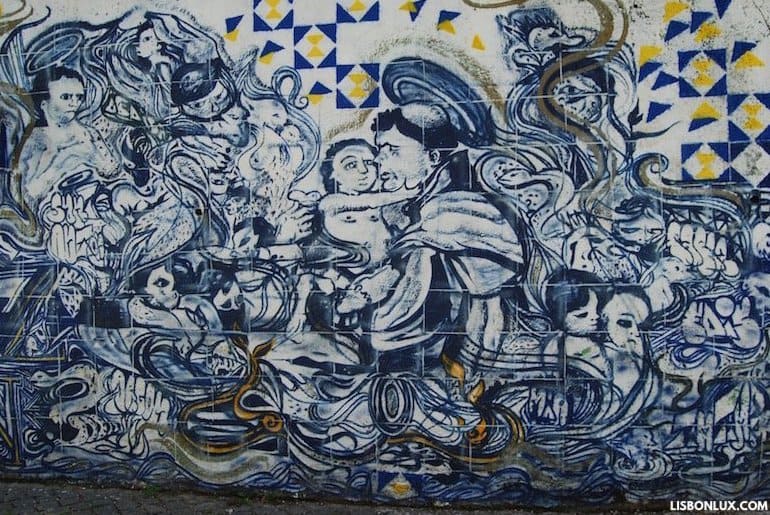
Portuguese artist Odith pays tribute to poet Fernando Pessoa in the Torel viewpoint , where there are also two murals by Pariz One and Argon close to Calçada do Moinho de Vento.
Santos
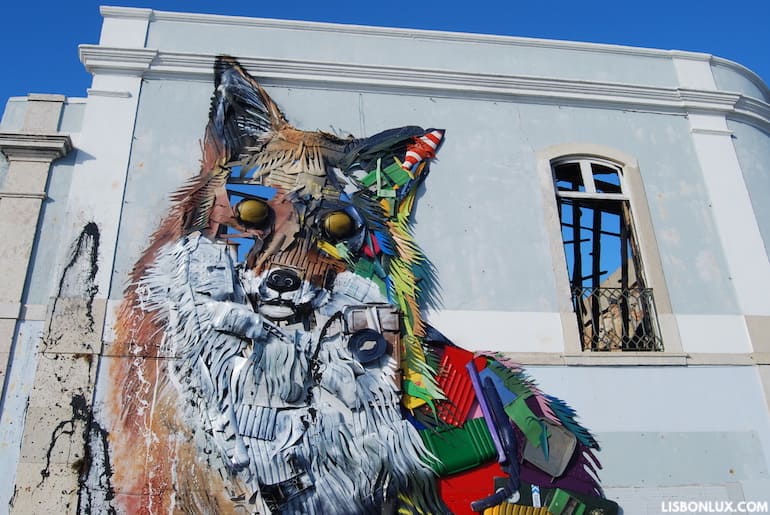
The facade of a warehouse that was almost completely destroyed in a fire was the choice of the artist Bordalo II to create yet another animal (this time a fox) from objects found in the trash. It can be seen on Avenida 24 de Julho, not far from the Ribeira Market.
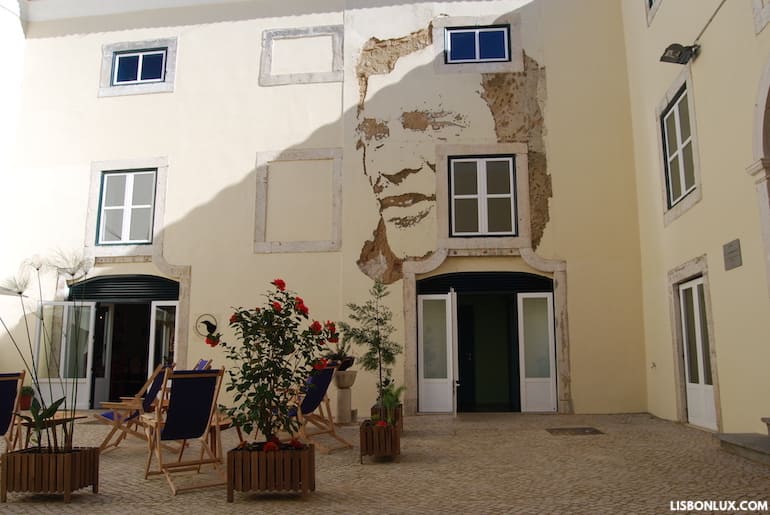
A former school on Rua das Gaivotas was the stage for a street art exhibition in 2008, and Vhils created a piece for the façade. Today the building has been renovated and is a cultural center, but the face carved by Vhils is still there.
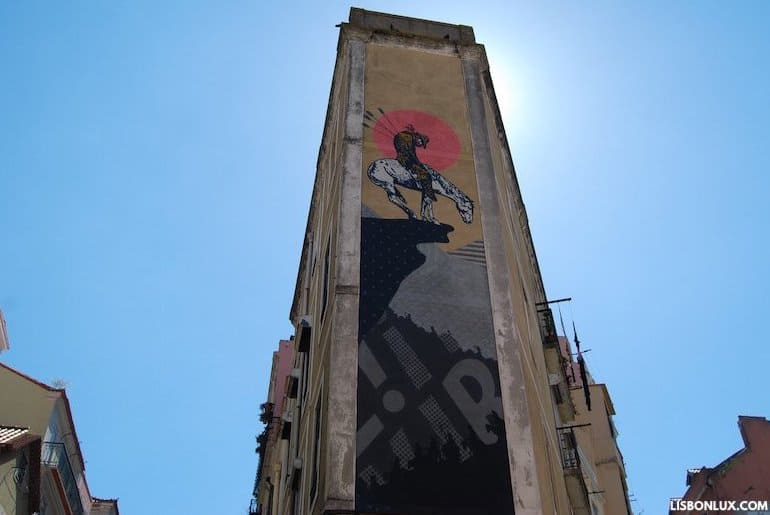
Look up on Rua Presidente Arriaga in the Santos district, not far from the Ancient Art Museum , and you’ll find this 2013 piece by Cyrcle, a two-man collective made up American artists Davey Detail and David Torres from Los Angeles.
Cais do Sodré
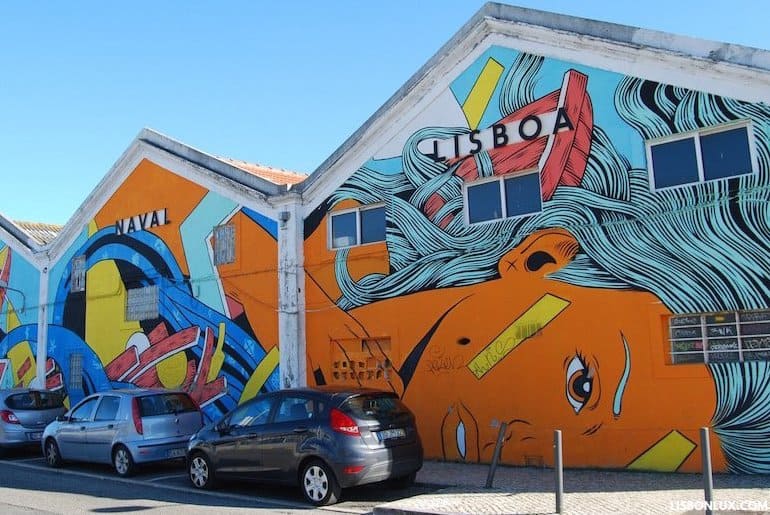
The old warehouses of Clube Naval de Lisboa, between the river and the train tracks on Rua da Cintura do Porto de Lisboa in Cais do Sodré , are now covered in a work of art by Bicicleta Sem Freio, a group of Brazilian artists.
Amadora
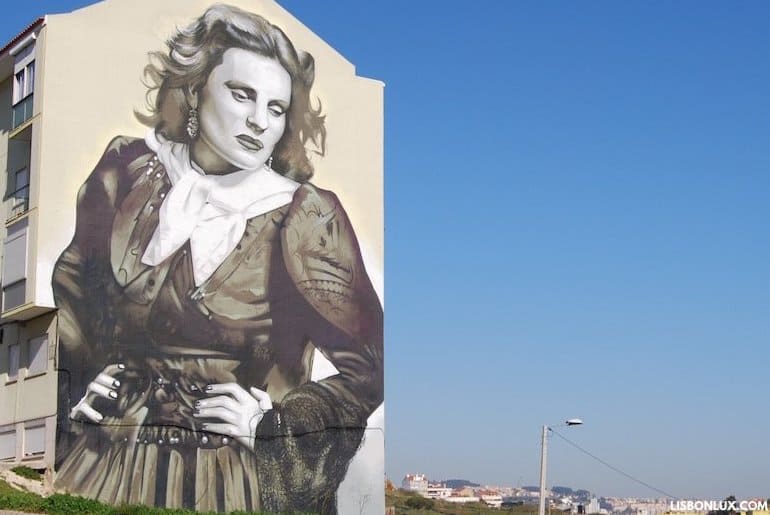
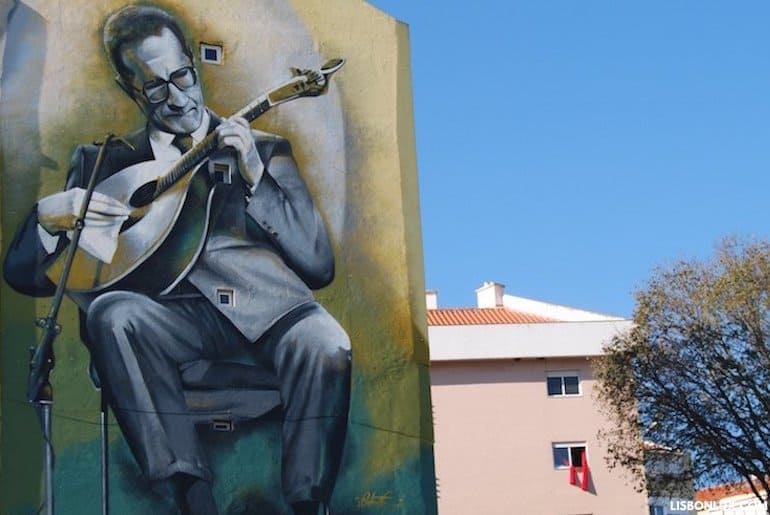
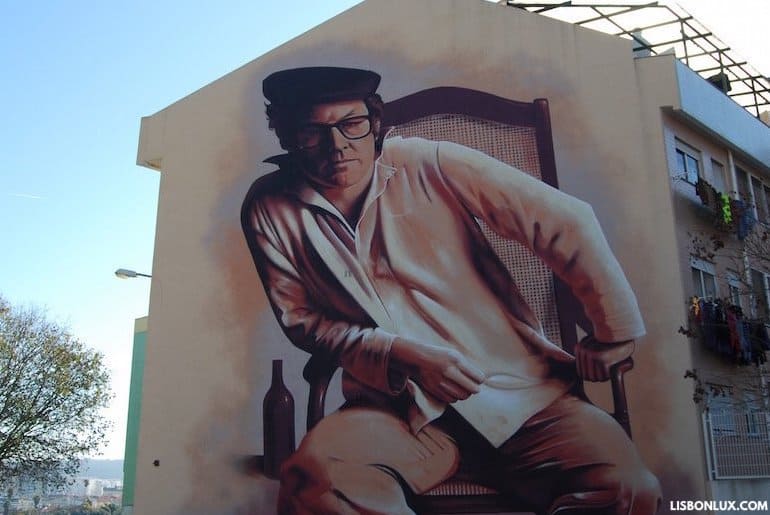
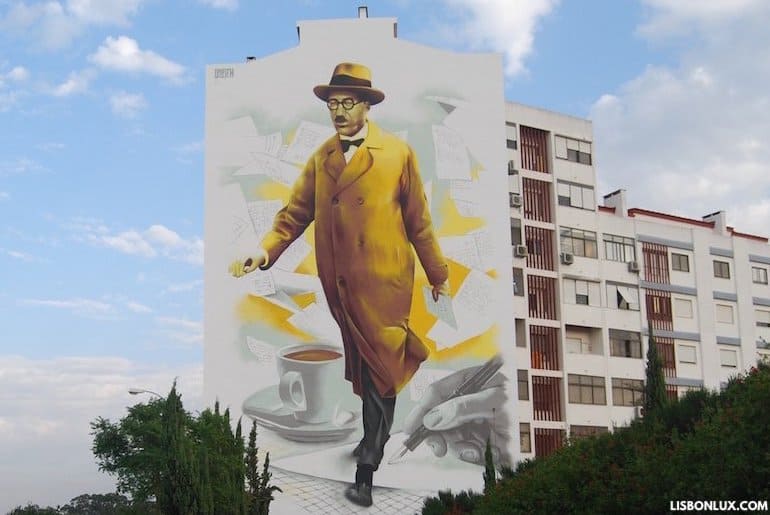
Outside the Amadora-Este subway station are several pieces by the artist Odeith, remembering two fado personalities -- singer Amália Rodrigues and guitarist Carlos Paredes -- plus activist Zeca Afonso and poet Fernando Pessoa.
Marvila
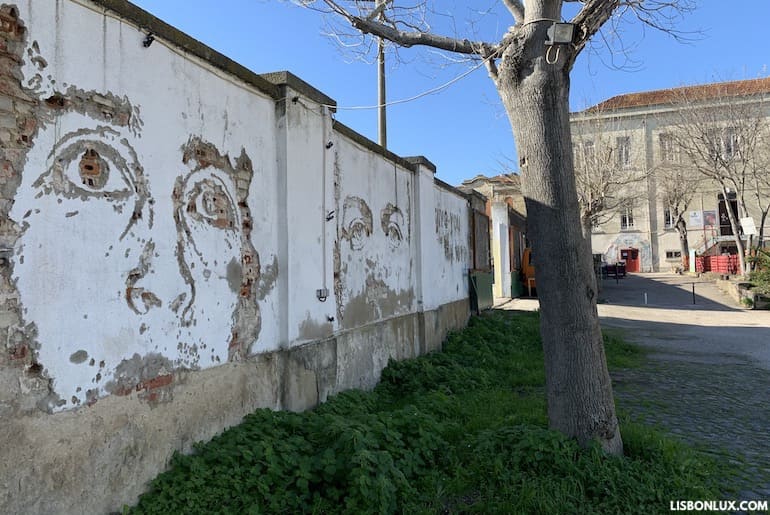
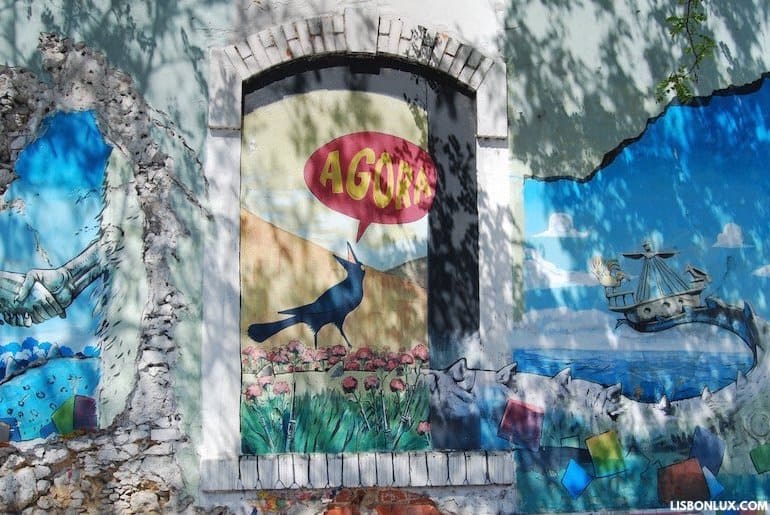
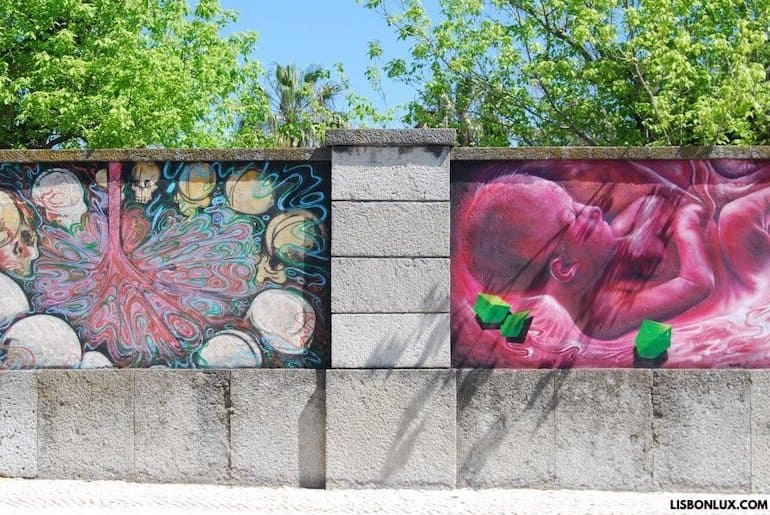
Both inside and outside the walls of Fábrica do Braço de Prata, surrounded by abandoned buildings, is always a variety of street art. It was here that Vhils carved his first faces, and today you can see a mural created in 2014 during the animated film festival Monstra .
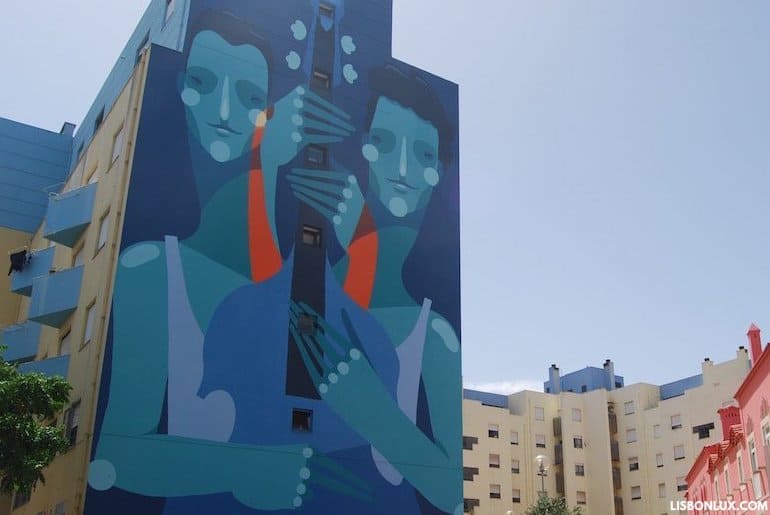
Lisbon’s street art festival, which took place in May of 2017, chose several buildings around the Marvila public library (which faces the Marvila train station) for the creation of several large-scale paintings by Portuguese and international artists. This one is found right next to the library and was created by the Spanish artist Zecar Behamonte, who now lives in Uruguay.
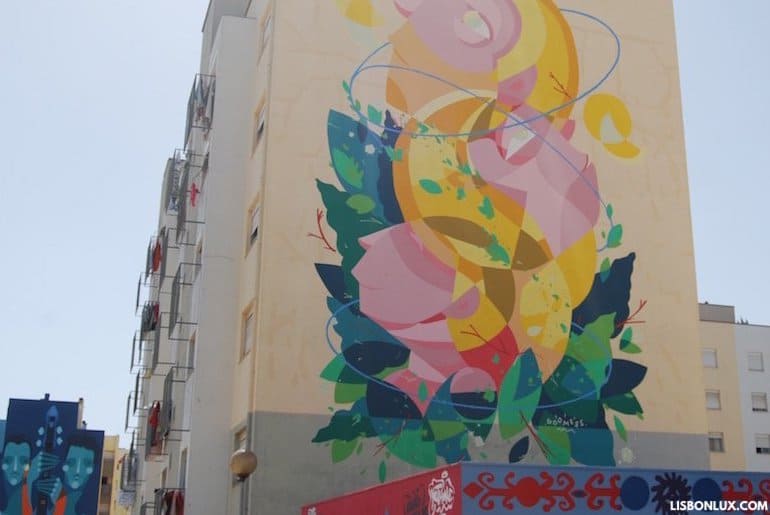
In the building across from it is a piece by the Portuguese “God Mess,” an artist from the city of Porto .
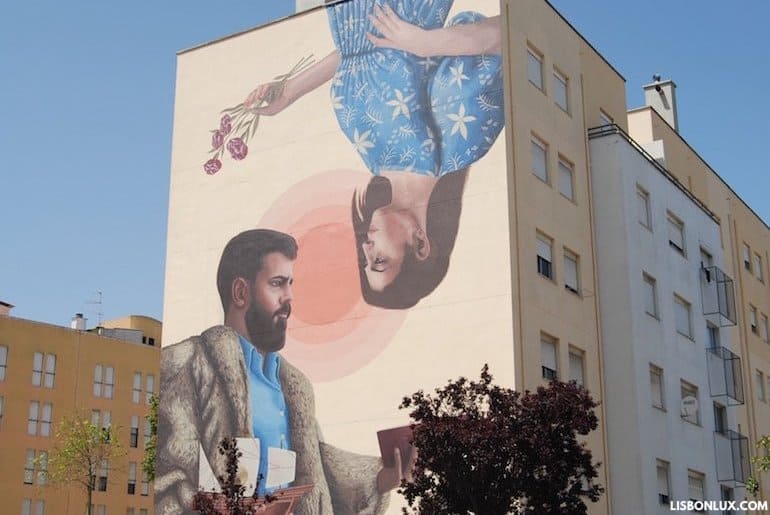
Heading north to Rua Alberto José Pessoa, you see this piece created by the duo Colectivo Licuado, from Uruguay, known for their semi-realistic illustrations.
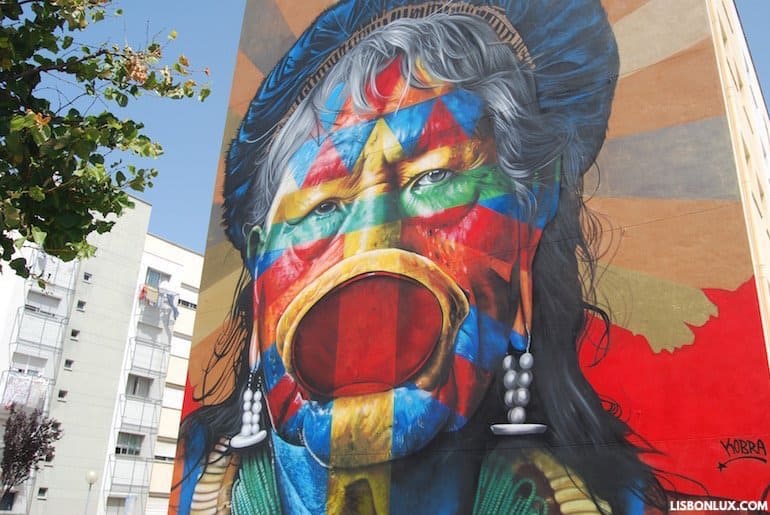
This piece, which covers the side of a five-story building, shows the face of Raoni, the Caiapó tribe's chief. It was created by the Brazilian artist Kobra, who says that he wants to draw attention to "the protection of indigenous peoples and ethnic groups, and the preservation of the Amazon rainforest."
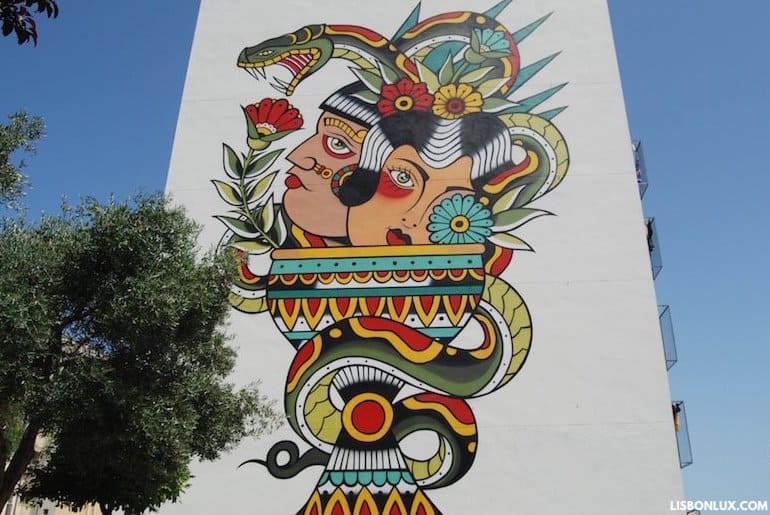
To the right of Kobra's work is this one by the Portuguese artist Miguel Brum, who draws inspiration from tattoos and the hip hop and punk cultures.
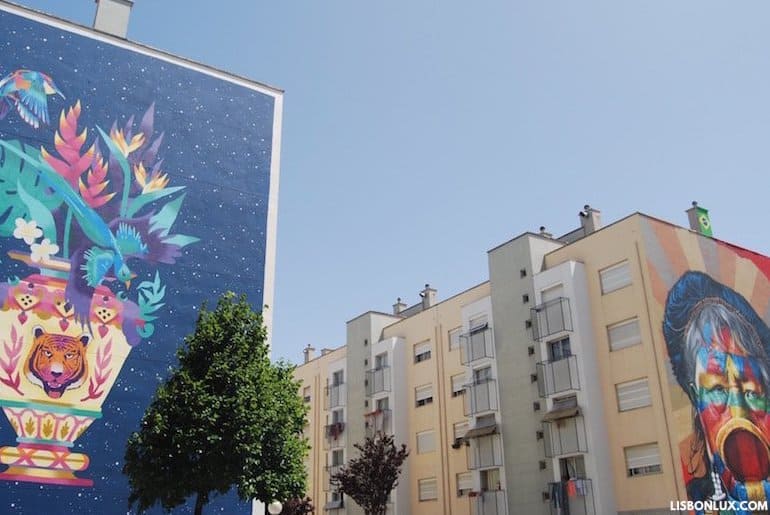
To the left of Kobra is a piece by the Portuguese artist Kruella d'Enfer, who creates universes of fantastic creatures, giving life to mysterious places and ancient tales.
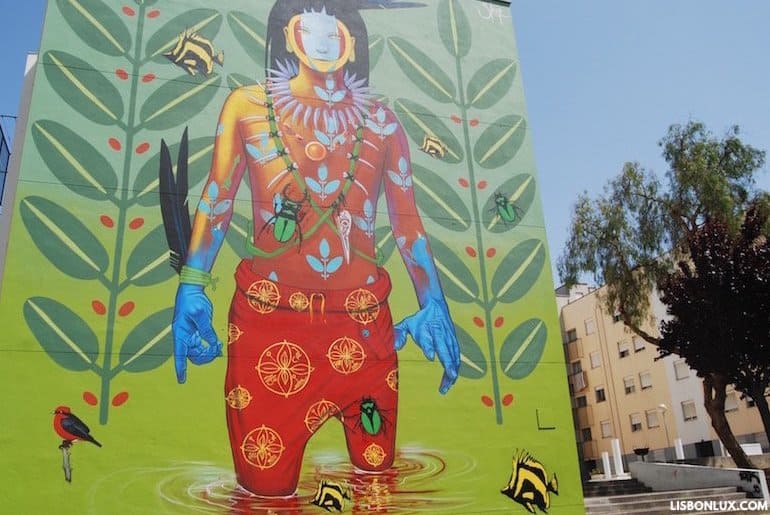
In the next building is a piece by the Ecuadorian artist Steep, who illustrates mystical creatures and environments, influenced by ancestral rituals and the biodiversity of the Amazon rainforest.

Hidden on a building across from Steep’s piece, is this one by the Portuguese artist The Caver.
Gone
Works that have disappeared, either because the buildings were renovated or demolished, or simply because they were painted over:
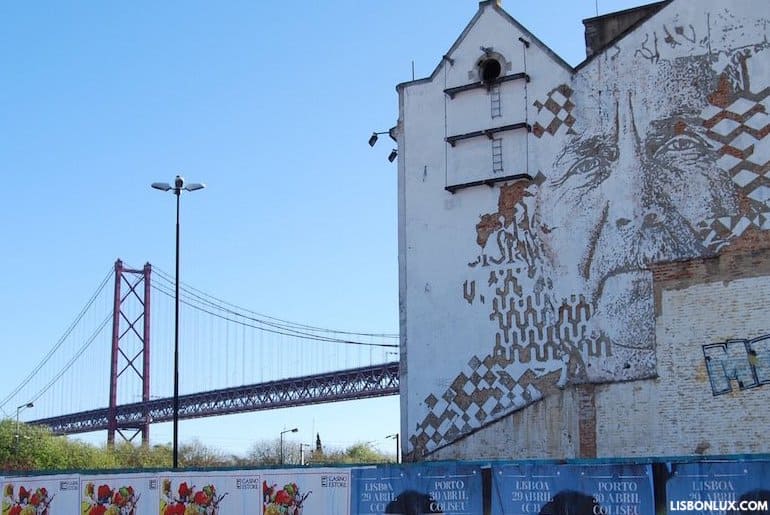
This piece by Vhils faced Rua de Cascais, close to the Santo Amaro Docks , but the building has been demolished.
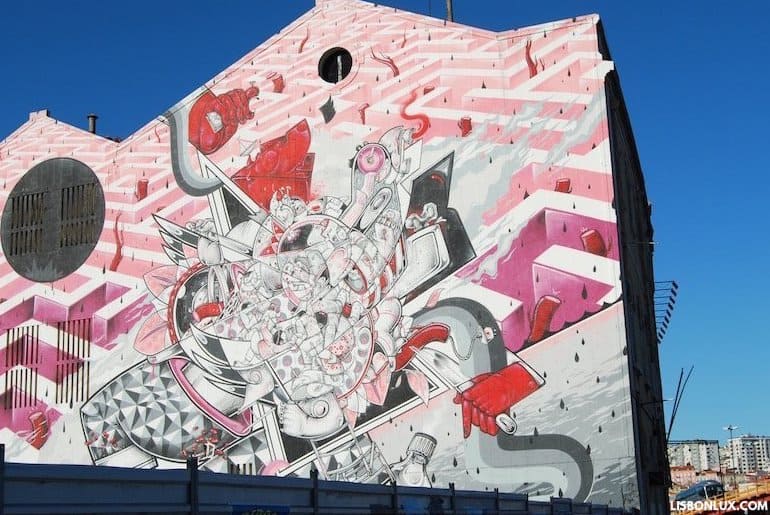
It was located a few feet from the piece above, facing 25 de Abril Bridge, on Avenida da Índia. It was created by Raoul and Davide Perre, better known as “How and Nosm,” German twins born in Spain and now based in New York.
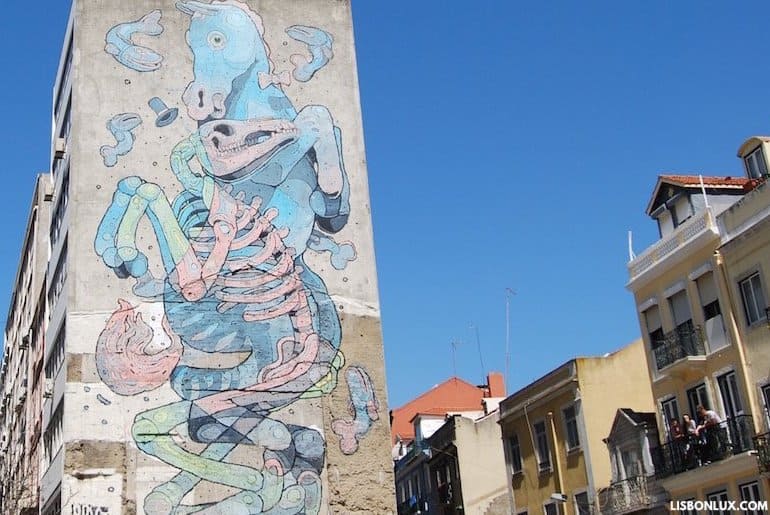
On Rua Rodrigues Sampaio, just around the corner from Avenida da Liberdade, there was once this 18m (59ft) horse rising up seven stories. Created by Spanish artist Aryz in 2011, it was Lisbon’s tallest street art project but has been covered by a new building.
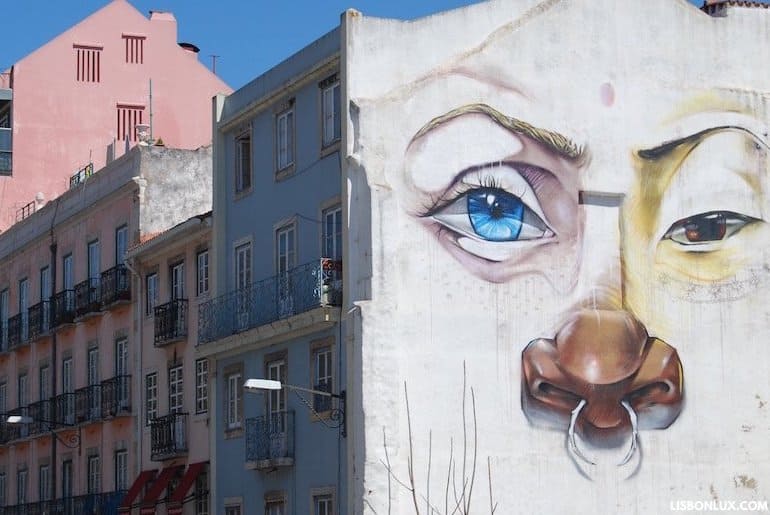
Lisbon artist known as “Drawing Jesus” was responsible for this face that drew the attention of anyone arriving at São Bento Palace . It has been hidden by a new apartment building.
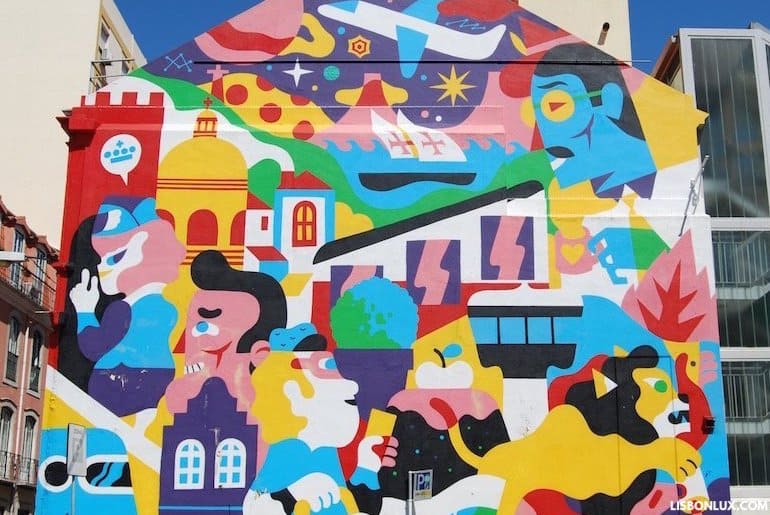
This mural on Rua de São Bento was commissioned by KLM to commemorate 75 years of regular flights between Lisbon and Amsterdam. AkaCorleone got together with Dutch artist Hedof and created this colorful mix of the two capitals.
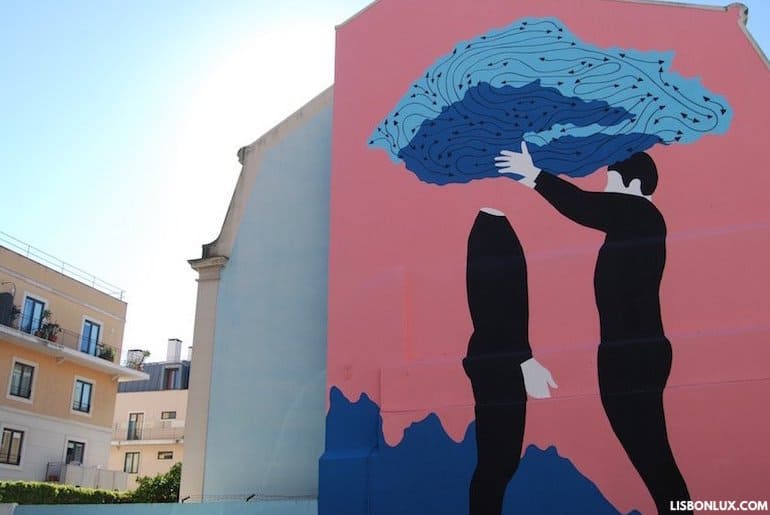
Facing the AkaCorleone mural, this piece by André da Loba was part of the "Days of Disquiet" event that took place in November of 2016, promoted by the José Saramago Foundation and Casa Fernando Pessoa. According to the artist, it represented a “storm of emotions."
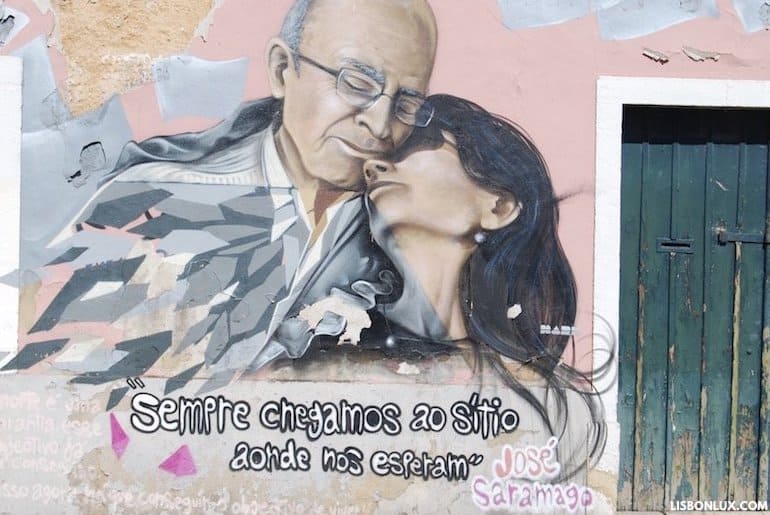
This work by Ayer, Nomen, Nark and Pariz was found on Campo das Cebolas by Casa dos Bicos and had been inspired by "José and Pilar," the documentary about Nobel Prize author José Saramago. The empty building was demolished to make room for a car park.
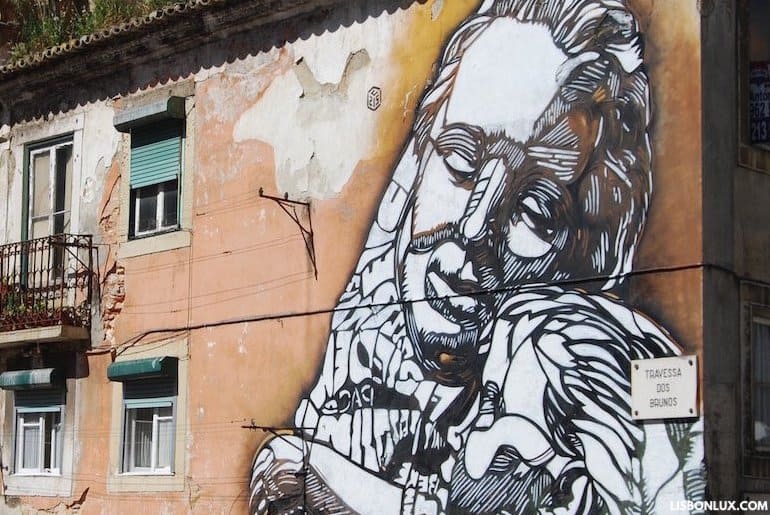
This 2012 reinterpretation of Madonna and Child was by French artist C215, one of the biggest names in street art world. It was created using reversed words, but disappeared during the building’s renovation.
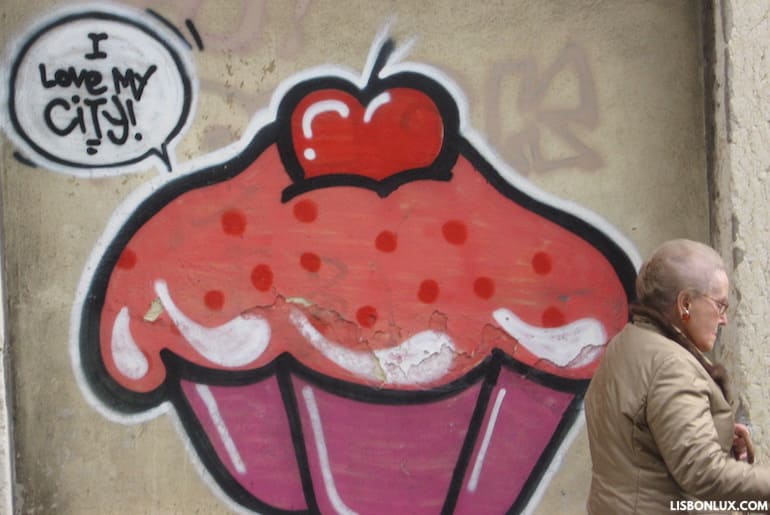
Illustrator Maria Imaginário was one of the first artists to add some color to Lisbon’s abandoned buildings, painting ice creams and other sweet things. These works appeared all over the city, but it seems that none were able to survive time.
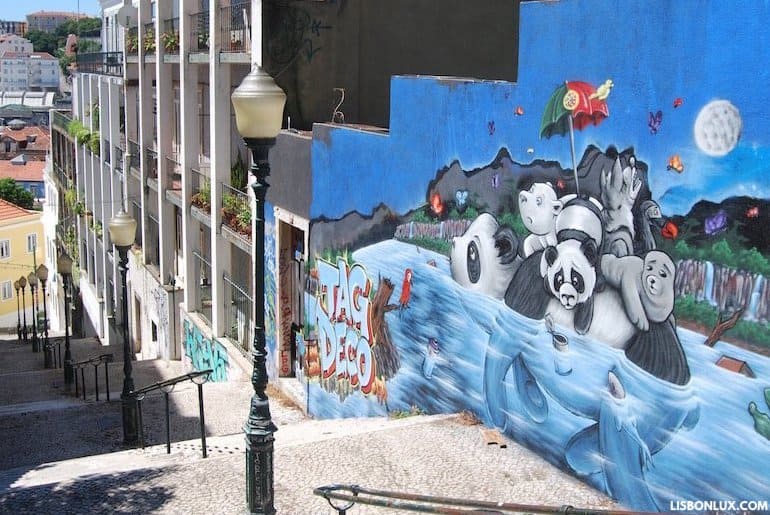
The steps leading to the Torel viewpoint were quite popular among street artists for quite some time. But when vandalism and illegal graffiti joined the "official" art, everything was painted over, and no paintings of any kind are now allowed.
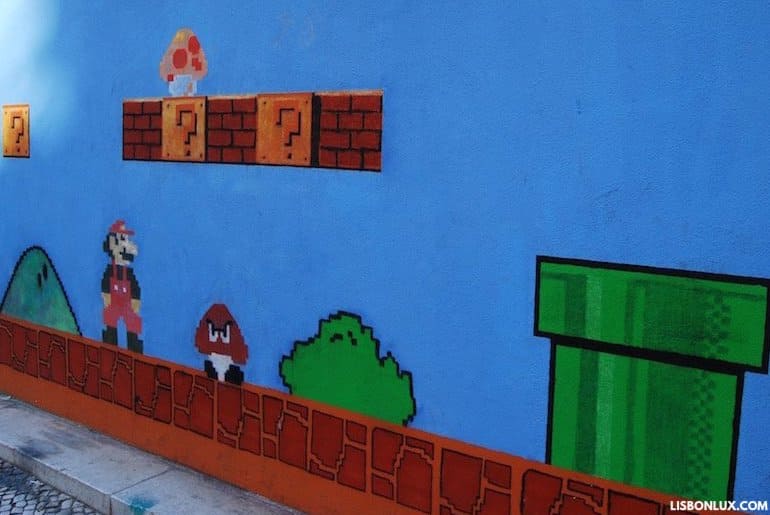
This curious image of Nintendo’s Super Mario I was found on Rua Ivens in the Chiado district. It was created by the artist Maria Sasseti, who decided to add some color to a street that had endured several construction works at the time.
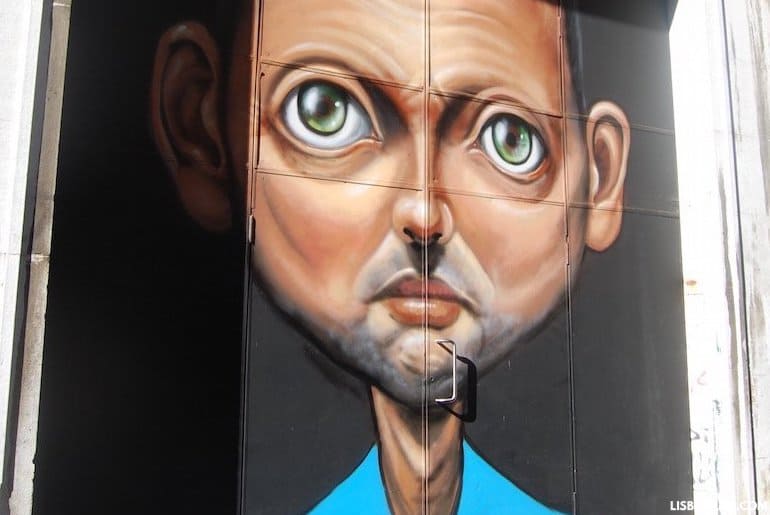
German-born Portuguese artist Paul Neberra was invited to paint the door of Teatro do Bairro, on Rua Luz Soriano in Bairro Alto . This was the first time he spray-painted, as he mostly uses acrylics and oils. He defines his work as a mix of pop, gothic, and surrealist culture, in an underground style inspired by street art.
Vhils teamed up with Italian artist Pixel Pancho and spent four days working on this building on Jardim do Tabaco in Alfama . These works blended the styles of the two artists, with Pixel Pancho’s signature robotic imagery and Vhils’ chiseled portraits. Unfortunately the building had to be torn down to make room for Lisbon's new cruise terminal.
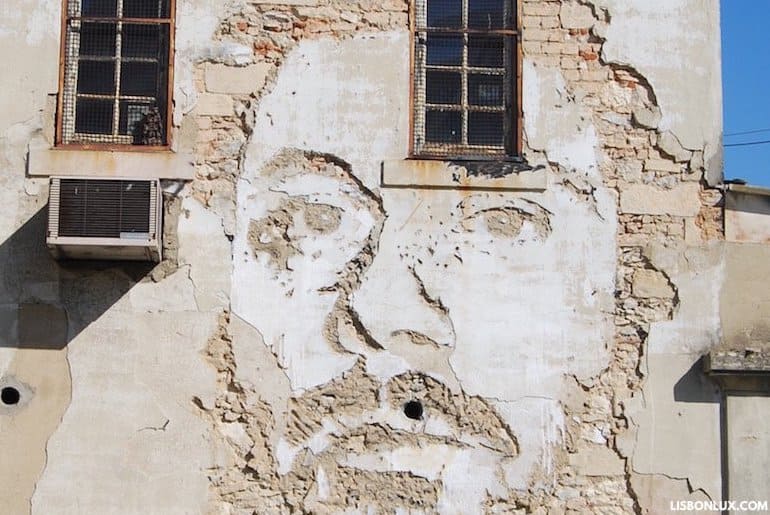
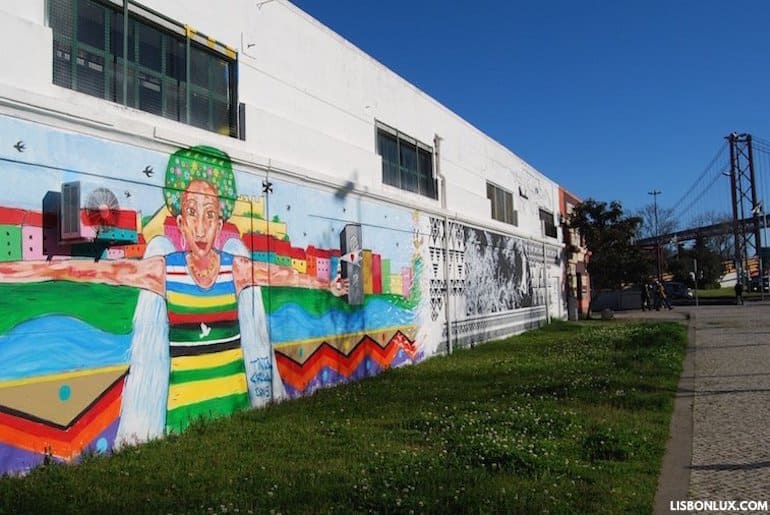
The first face that Vhils carved, or rather, sculpted, on a wall in Lisbon was this one on Rua de Cascais in Alcântara . It’s the face of the American artist Brad Downey, his friend, which was seen among other works by other artists on a wall that was part of the Street Art Gallery until it was torn down in the summer of 2016.
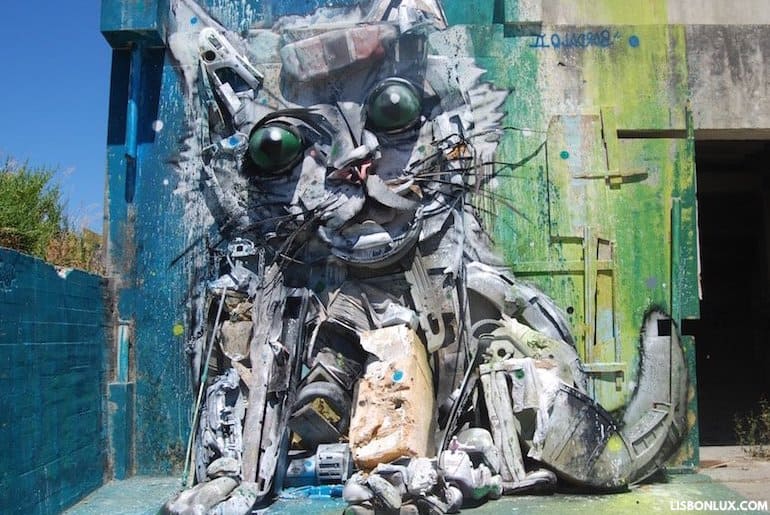
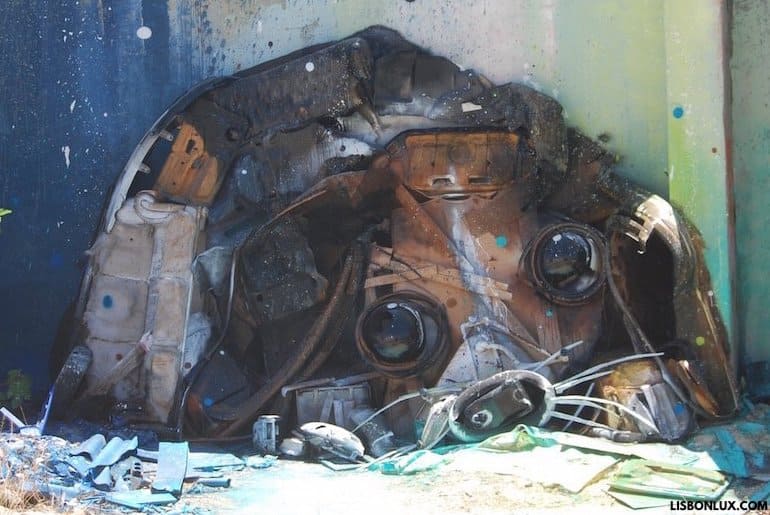
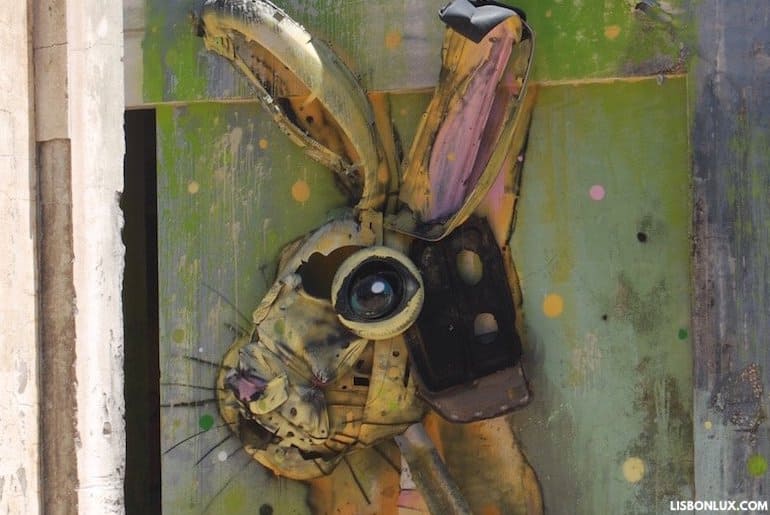
These impressive pieces made from trash were found hidden between abandoned buildings on Avenida Marechal Gomes da Costa, by the Parque das Nações district. It was a curious "abandoned dog," a giant cat and a rabbit, all created by the artist Bordalo II.
Follow Lisbon on social media:
INSTAGRAM: instagram.com/lisbonguide
FACEBOOK: facebook.com/lisbonlux
TWITTER: twitter.com/lisbonluxcom
